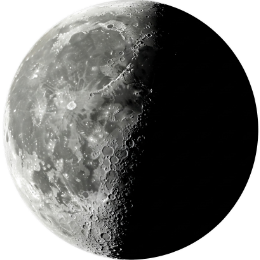
432 AND ABOVE EME NEWS
APRIL 2025
Volume 54 Number 4
Editor: Peter Blair G3LTF
Production Assistance: Frank NC1I & Bob W1QA
NEWS CONTESTS and DXpeditions
G3LTF Editor
The Radio Society of Great Britain Honours Dr Allen Katz, K2UYH
At the AGM on April 12, 2025, the RSGB posthumously awarded K2UYH a Lifetime Achievement Award. See below for the full citation.
The IARU Region 1 interim meeting in Paris, April 26/27th, agreed that work needs to start on a 23 cm band-plan revision to take account of the expected regulatory developments once ECC Decision (25)01 is finalised around June this year. This work will be done by a task force of IARU Region 1 member society VHF managers, chaired by Barry G4SJH, which will produce a proposal for the next IARU Region 1 conference in September 2026. The draft can be found here: https://cept.org/files/2099/Draft%20ECC%20Decision%20(25)01.docx
Matej, OK1TEH, is stepping down as associate editor due to pressure of work. We thank him for his help in getting the newsletter back up and running again and look forward to his radio-astronomy contributions as he is able to make them.
Contests
The DUBUS-REF CW/SSB contest generated moderate activity, it looks as if there were at least 70 stations active overall. Highest QSO numbers appear to be OK2DL with 65 followed by G3LTF with 56 and SP9VFD with 51, activity from North America was lower than in previous years. QSB was quite difficult especially on the 6th April. On top of the usual libration fading there was a major magnetic storm taking place and several stations mentioned experiencing difficult copy. Some QSOs took place with OH2DG at 1298 MHz. The other OH stations operating on 1296 MHz were all operating at low power (but still had good signals!)
Before the contest, on April 4th, a few stations were active on SSB for the DJ3JJ “appetiser” contest, The results are listed below in DJ3JJ’s report. Thank you for your work in setting it up Andreas.
May 3rd is the DUBUS-REF 9 cm CW-SSB contest. Rules are at http://www.marsport.org.uk/dubus/EMEContest2025.pdf Please also see the clarification in last month’s NL.
Jan, PA0PLY suggests that the following day, Sunday May 4th is used as a 9 cm activity day with all modes and logger use allowed, as was done following the 2.3 GHz contest.
ARRL 2024 EMEContest Results
There were some big problems in the May 2025 QST article with some of the scores, particularly with some CW entries. The ARRL believe they have fixed the issue and that the online results will soon be available. The QST page will be redone but only for the on-line and webpage versions.
DXpeditions
As this is being written, HD8G, operated by Bruce PY2BS, is making many QSOs with his 2.4 m folding dish and 200 W, putting the Galapagos Island on microwave EME for the first time. (We hope for a full report next month Bruce!)
Bernie ZS4TX is activating Angola as D2TX and Namibia as V5/ZS4TX.
D2TX (JH74) on 02 May 2025 on 70 cm EME and the following day depending on demand. https://www.qrz.com/db/D2TX
V5/ZS4TX (JH92) from 06-08 May 2025 on both 2 m and 70 cm EME
K2UYH Receives RSGB Award
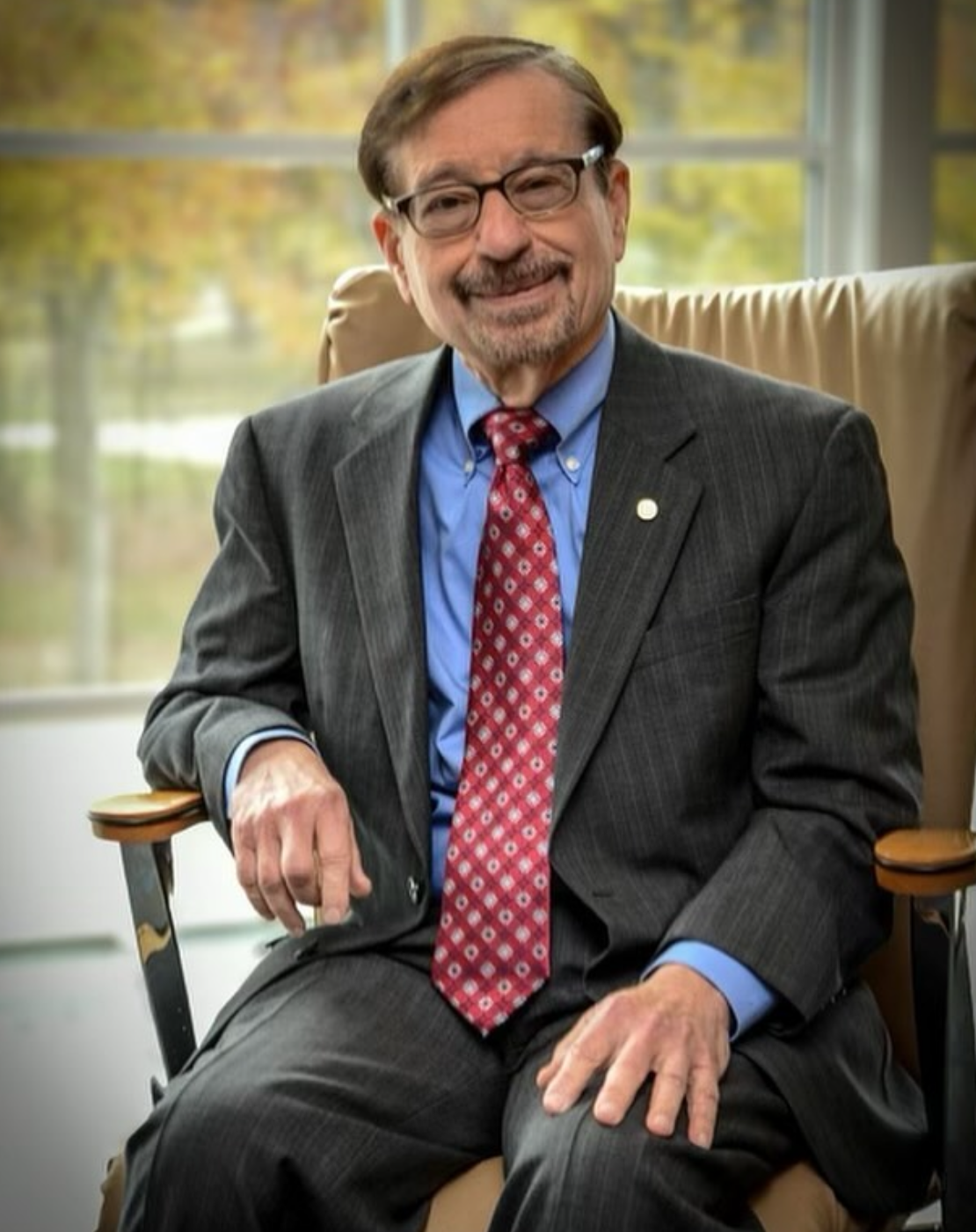 K2UYH Al Katz
K2UYH Al Katz
Awarded to recognise an outstanding contribution to amateur radio over an extended period.
This was awarded to Dr Allen Katz, K2UYH Silent Key. Allen was a pioneering figure in amateur radio and electronic engineering. Licensed at 13, he became a leader in VHF/UHF moonbounce (EME) communication while pursuing an academic career. As a professor at The College of New Jersey, he was deeply dedicated to his students, often welcoming them into his home. He co-founded the Trenton Personal Computer Festival and several engineering ventures to support student learning.
His passion for amateur radio led him to establish EME contacts worldwide, organise DXpeditions, and launch the long-running 432 MHz and Above EME Newsletter, fostering a global community. With a very large dish on 432 MHz he was the first person to achieve Worked All Continents on 70 cm. His efforts helped shape international moonbounce conferences, uniting enthusiasts. Known for his enthusiasm, persistence, and unwavering support from his wife Sally, Allen’s impact was profound. His passing leaves a significant void in both the academic and amateur radio communities, but his legacy will continue to inspire future generations.
Reproduced with the kind permission of the RSGB - RadCom May 2025
BA7NQ Terry
Jan, PA0PLY, forwarded this report from Terry BA7NQ. Previously there were not many active in China on EME but this is changing and many young hams are getting interested. They operated BA7LOK (see QRZ.com) on 5th and 6th April, with a 3 m dish and 200 W at the same time talking and sharing experiences about EME and microwaves at the 1st China Amateur radio space communication and microwave technology symposium. See photo.
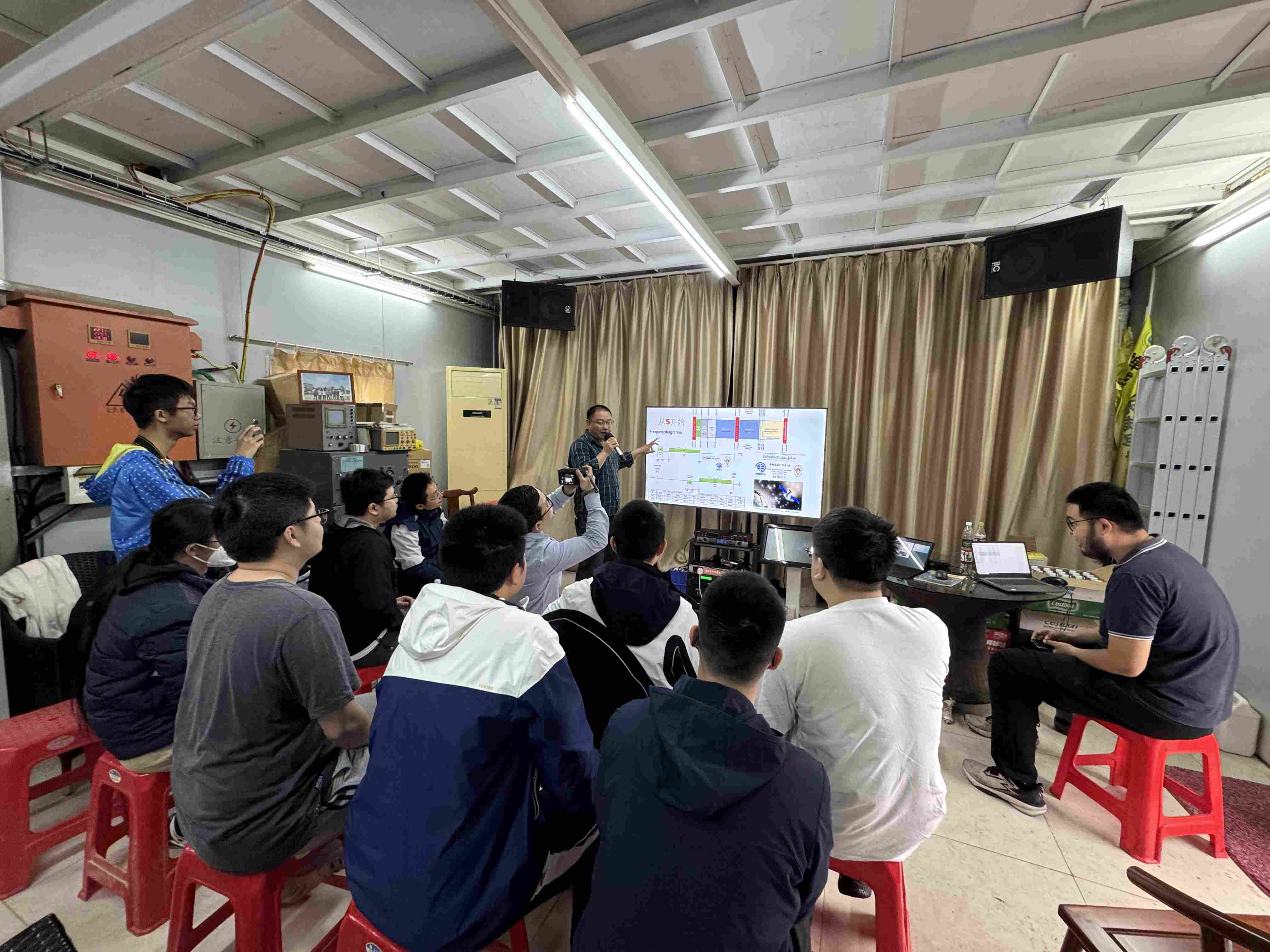 1st China Amateur Radio Space Communication & Microwave Technology Symposium 2025 Presentation
1st China Amateur Radio Space Communication & Microwave Technology Symposium 2025 Presentation
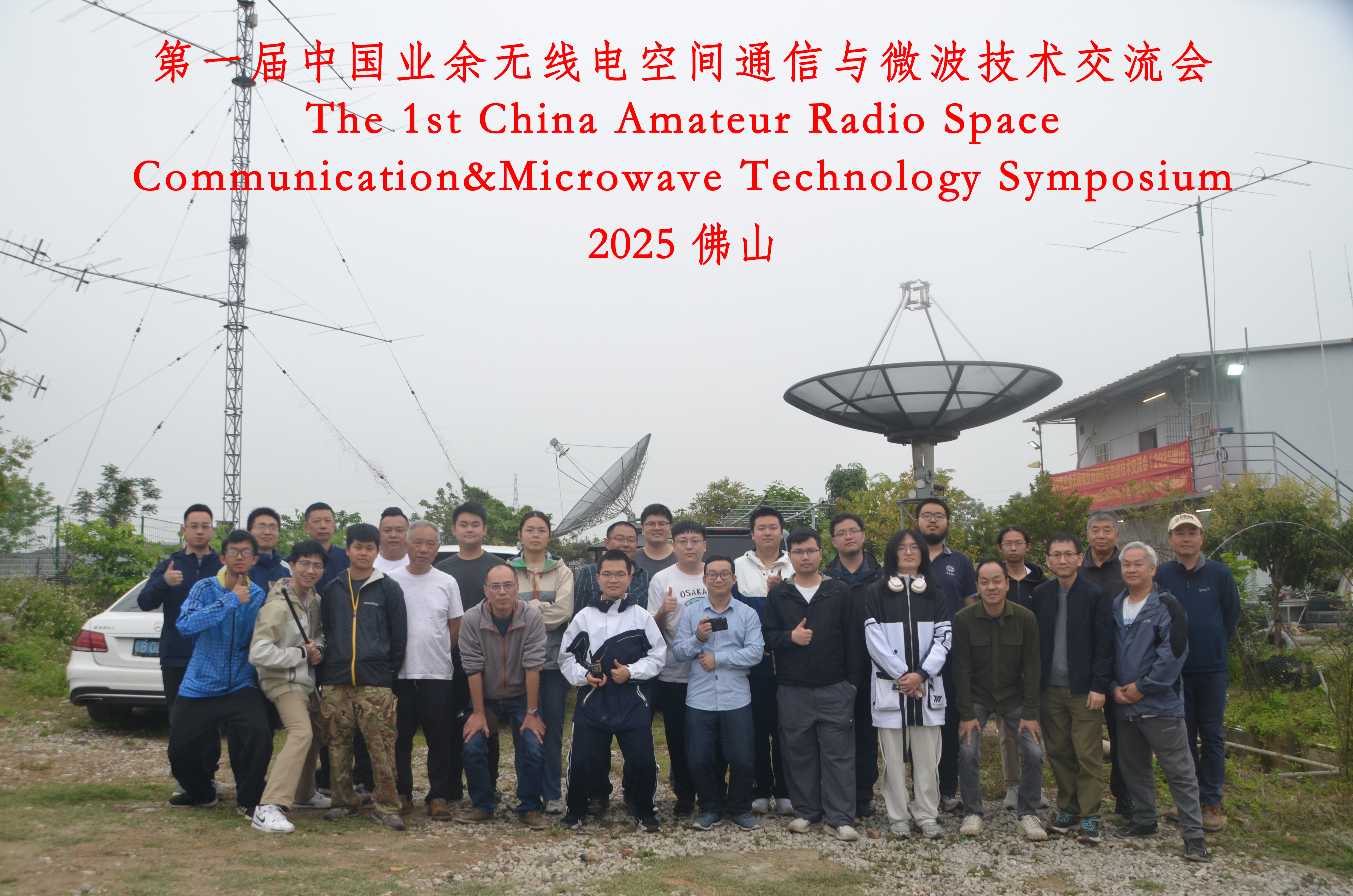 1st China Amateur Radio Space Communication & Microwave Technology Symposium 2025 Attendees
1st China Amateur Radio Space Communication & Microwave Technology Symposium 2025 Attendees
DJ3JJ Andreas
For the 2nd 23 cm EME SSB Appetiser contest on Friday 04 Apr 2025: In total there have been several stations qrv with DL1AT with 3 m dish as smallest and PI9RD 25 m as biggest. From the sent in logs the Classification result is as follows:
1st - G3LTF (6 m) with 2 Continents and 120.000 Points
2nd - IK1FJI (3.8 m) 1 Continent and 30.000 Points
3rd - XE1XA (5 m) and PI9RD (25 m) with 1 Continent and both 4.000 Points
Many thanks for the participation on the Friday before the Dubus Contest. I got the feedback that people would prefer to have the contest on a weekend, so I will see how we can find a better date. If you have any other feedback on how to improve the event, please let me know.
DL3WDG Charlie
All was going well in the days prior to the 13 cm Dubus contest and the activity period the day after. I installed a new SSPA at the feed with about 175 W out. All went well during initial tests with Q65, but on trying (break-in) CW using a new rig at 144, I had my first (of three) preamp failures. T/R sequencing was based on a protection relay that has additional DC contacts that switch on the PA drain voltage once the relay has changed over to switch the preamp from the feed to 50 ohms. This scheme has worked well for many years on all other bands.
I built a diode detector to monitor the RX port on the feed, and using a scope triggered by the PTT, it showed short bursts of RF. One occurred on starting to transmit, the other when going back to receive. The initial one was about +15 dBm and the second up to +24 dBm. Such levels are probably too much for the MGF4919 in the preamp.
The initial one was caused by drive (about 5 W) leaking through the PA in its 'off' state. The mistake here was to not sequence the drain voltage to the driver, which was then present at the same time as RF was generated from the transverter. The second one was more subtle, in that the PA oscillated at an intermediate drain voltage during the decay after removing drain voltage when going back to receive.
The 20 ms switching time of the relay thus gave two windows of opportunity for two potentially damaging levels of RF reaching the preamp.
After all this, I designed a completely new sequencer which delays the appearance of drive until the protection relay has switched, and then holds the protection relay on for a defined period after PTT is removed. Since doing this, no more problems! Unfortunately this took too long to be able to enjoy the contest and activity day.
Later I made QSOs on Q65: PA3EXV, G4DDK, PE1CKK. PA0PLY, OK1DFC, G4CCH, OH3LWP, DL1SUZ (inc Q65-15A) and CW: G4CCH and G3LTF.
I also had some problems with the TX chain of the transverter oscillating. This initiated a rebuild of the transverter based around my multi-frequency 13 cm receive converter (https://www.microwavers.org/eme2012/files/saturday/G3WDG_13cm-Downconverter_EME2012.pdf). I modifed this to steal some LO to feed a separate TX mixer based on an old W2CQH interdigital converter that I found in the garage. The new arrangement can be retuned to 2400 in a couple of minutes to also play QO-100. (See the picture of Charlie’s 13 cm offset feed; design and construction details are in Dubus 4/2023 - Ed)
I was also QRV briefly on 1296 and worked a number of stations, including KA1GT on Q65-15A.
WSJT-X-improved v2.8.0
A new "250501" release of WSJT-X-improved v2.8.0 is scheduled for early May. This will include a feature (LiveCQ) to allow messages that you decode with QMAP and/or MAP65 to be uploaded automatically via the internet to a new website: https://w3sz.com/livecqMsgWindow.html
The idea is to provide spots of active stations so that others will know where to look. The information on the website will allow you to tune to the right frequency, audio offset and mode/sub-mode. It can also be used to see who is decoding your own transmissions. We hope that this will be a useful tool, but it will only work if it is adopted by as many stations as possible! Should you wish not to disclose who you are decoding, the spotting function can be disabled.
Installers for the various program options will be found at https://sourceforge.net/projects/wsjt-x-improved/files/WSJT-X_v2.8.0/
The User Guide has been updated to include details of LiveCQ, and other new features (such as mouse control of rig tuning).
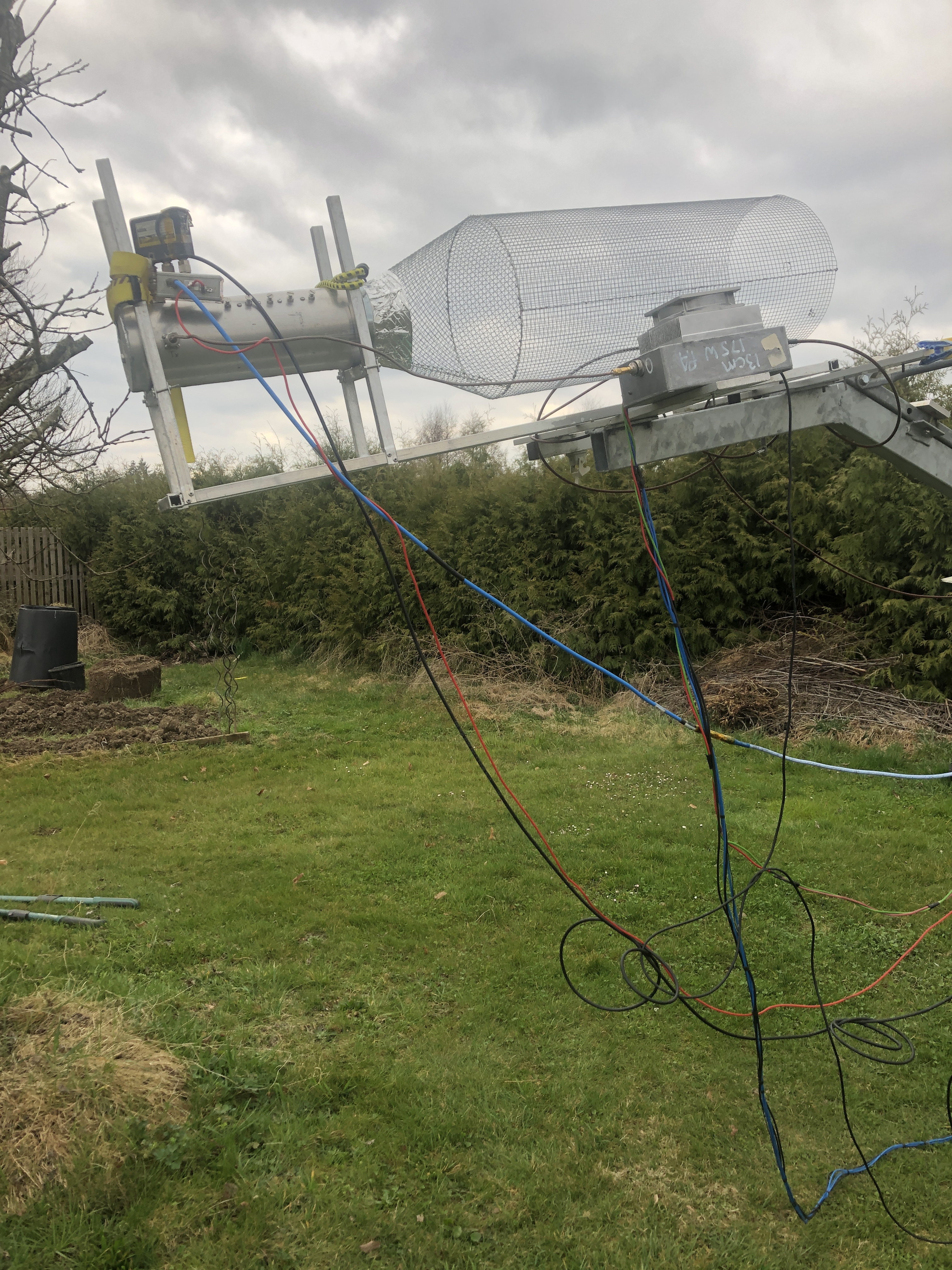 DL3WDG 13cm feed
DL3WDG 13cm feed
F6ETI Philippe
This weekend was the EME REF-Dubus "Memorial VK3UM" contest on 1296 MHz.
A bit of a struggle to get off to a (relatively) rough start with the first moon pass on Saturday, but ultimately, finished with 24 QSOs. A few regulars were absent, or unfortunately SKs since the last contest. Contacted, all random, no chat, no skeds, and no loggers: OH1LRY, HB9Q, DU3T, FX1A, OK2DL, OK1DFC, SP6JLW, G3LTF, G4CCH, PA3DZL, PI9RD (formerly PI9CAM), IK3MAC, DF3RU, OK1KKD, WA6PY, VE6TA, IK2DDR, F5KUG, IK1FJI, SP9VFD, CT1DMK, SM2CEW, OZ6OL, OE9ERC (#113). Heard and not "hooked": F5JWF and SP3TLJ.
Results much better than in 2024 (15 QSOs), and for previous years: 23 QSOs in 2023, 20 in 2022, but 35 in 2020! Operating conditions: Home made 300 watts at the septum feed, 3-meter dish, NF 0.37 dB, Sun/CS 14 dB - SFI 178. Friday, before the contest, during the proper functioning tests, QSO with G3LTF and VE6TA.
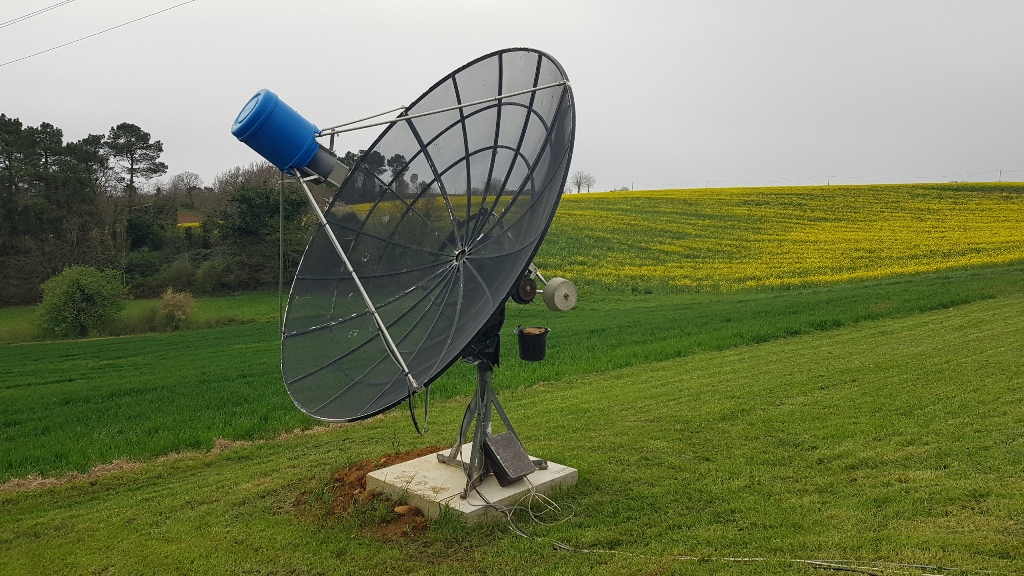 F6ETI 3m dish
F6ETI 3m dish
F6KRK / F4BUC Matt
We finished the REF-DUBUS contest with 20 QSO. We are pleased to log the following stations : CT1DMK (#129), DF3RU, FX1A (#128), F5KUG, G3LTF, G4CCH, HB9Q, IK3MAC, IK1FJI, OH1LRY, OK1DFC, OK2DL, OK1KKD, OZ6OL, PA3DZL, PI9RD, SP9VFD, SP6JLW, UA3PTW, WA6PY. Heard : OK1VUM, DU3T. Two new initials in our log: FX1A and CT1DMK.
Amazing to have contacted two European radiotelescopes: FX1A (La Villette in Paris) and PI9RD (Dwingeloo)!
Our working conditions are a 3,1 m parabolic dish with a RA3AQ feed, a G4DDK VLNA and 200 W power at the feed.
We measure 16 dB sun/cs these days with SFI 175. (Thats an excellent result for a 3.1 m dish - Ed)
In the future we plan to replace our dish with a larger one, 4,5 m diameter would be fine (If you want to get rid of a TVRO dish of this size, do not hesitate to contact us!)
CW activity on EME is fascinating because you feel perfectly how the signals are travelling along the path and you feel more the human presence of the remote operator. Digital modes are more efficient to work small stations but the QSO is achieved by two computers chatting together. Another interesting point: telegraphy still fascinates people. At F6KRK, we regularly organize CW workshops for the general public, and they are the most successful. So if you want to promote EME in your radio club or among the general public, play them the CW sound.
Visit our website (in French): https://blog.f6krk.org/category/eme/
G0JDL John
This month I worked a further five initials on 70 cm: OQ100R, SM4GGC, JF6CTK, PA0GRU (operating the PA6Y station) and PI9RD. I addition I had QSOs with OZ9AAR, DL1VPL, OE3JPC and NC1I. I had the usual frustration of not being able to work several stations that should, in theory at least, should be fairly easy for me but it looks like Faraday rotation was doing its very best to prevent a QSO on most of those occasions though sometimes there appeared to be one-way propagation where I could see or even hear a station but they couldn’t copy my signal despite the fact that, 30 minutes earlier, I’d managed to work a smaller station. Although my total 59 QSOs and 29 initials in five months is certainly rather modest compared to lot of stations, I’m happy so far with the results of operating such a small system.
The new Yaesu G5500 rotator is doing a great job and operating has become so much easier now that I don’t have to take regular trips into the garden to move my antennas and of course I no longer have the uncertainty of wondering whether I am actually pointing at the moon on cloudy nights. It was definitely somewhat unreliable using mobile phone compasses (ok for elevation but sometimes wildly adrift in azimuth even after calibration) or a magnetic compass.
I now keep looking at my system and wondering if I should fit another two antennas. I probably shouldn’t as it will make it rather heavy to move around when required but the extra gain would be nice! (As you say, Faraday rotation can really spoil your day as Ian GM3SEK explains here http://www.ifwtech.co.uk/g3sek/eme/pol4.htm - Ed)
G3LTF Peter
Here is my activity in late March-April. All QSOs are CW unless otherwise noted. On March 28th I put the 13 cm feed in and worked DL3WDG #163 for our 4th band. Checking the gear on 3rd April before the DUBUS contest I worked F6KRK. On 4th April I worked RX3DR, IK2DDR, CW and SSB, F6ETI OK2DL SSB, G0LBK SSB, G4CCH SSB, DL1AT SSB, G4KLX, #558, OK1VUM, XE1XA SSB and DF3RU SSB. The 7 SSB QSOs were entered into the DJ3JJ “appetiser” contest.
On 5th April in the DUBUS contest I worked the following; PI9RD, DU3T, SP6JLW, SP3TLJ, RX3DR, OK2DL, OH1LRY, VK5MC, IK1FJI, IK3MAC, PA3DZL, DL6SH, DL1AT, F5JWF, SP3XBO, SM3BYA, CT1FGW, HB9Q, SP9VFD, RA4HL, F6ETI, G0LBK, CT1DMK, FX1A, ON5GS, F5KUG, IK2DDR, CR5A, OZ6OL, F6KRK, I5YDI, OM4XA, VE6BGT, VA7MMN, VE6TA, NQ7B, WA6PY, K5DOG, G4CCH, SP6GWN, OK1KKD, DL4DTU. On 6th April: UA3PTW, DF3RU, OK2PE, OH3LWP #559, DJ3JJ, IZ1BPN, SM2CEW, K3COJ, OK1VUM, OK1DFC, G4RGK, SV3AAF and WB8HRW. Total claimed score of 56 x 48. Got-aways were: IQ2DB, XE1XA and PA0PLY. The SDR screen shot shows about 15 stations at 15:22Z on April 6th, not the busiest time. On the frequency scale 14.000 = 1296.000.
On March 29th we had, in the UK, a minor solar eclipse so I made a set of measurements of 23 cm sun noise, referenced to my 50R load to reduce the effect of gain drift. The predicted curve comes from the VK3UM EME planner. The level of the drop agrees very closely and the onset precedes the optical, as expected as the suns radio diameter at 23 cm is 1.1-1.2 times the optical, but the return to normal is faster than I expected. I don't know why.
I had a great time at the Martelsham Round Table, meeting lots of EMErs and getting all my preamps re-measured. I had a nice meal with some old PA friends.
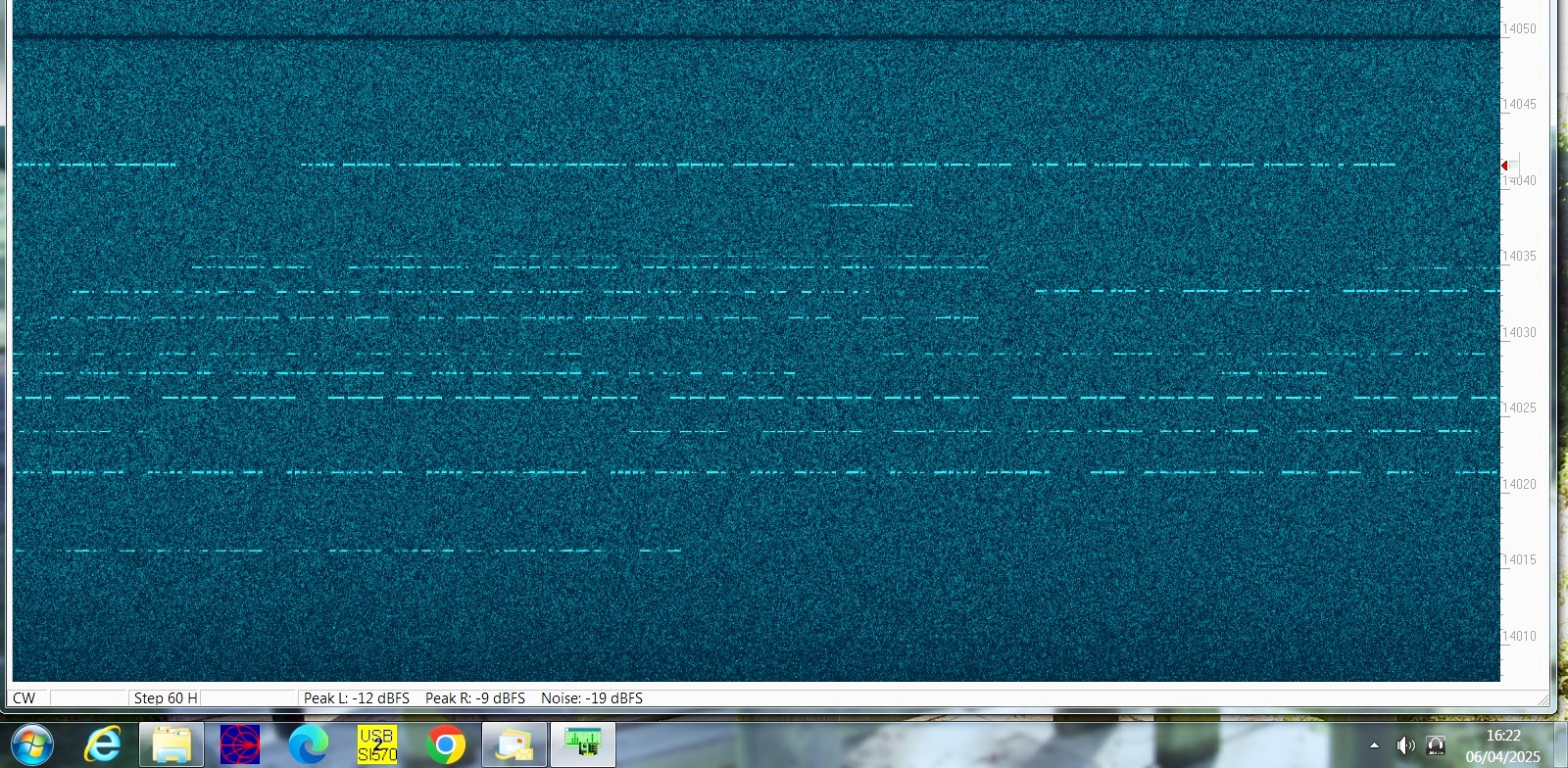 G3LTF SDR screen DUBUS 23cm
G3LTF SDR screen DUBUS 23cm
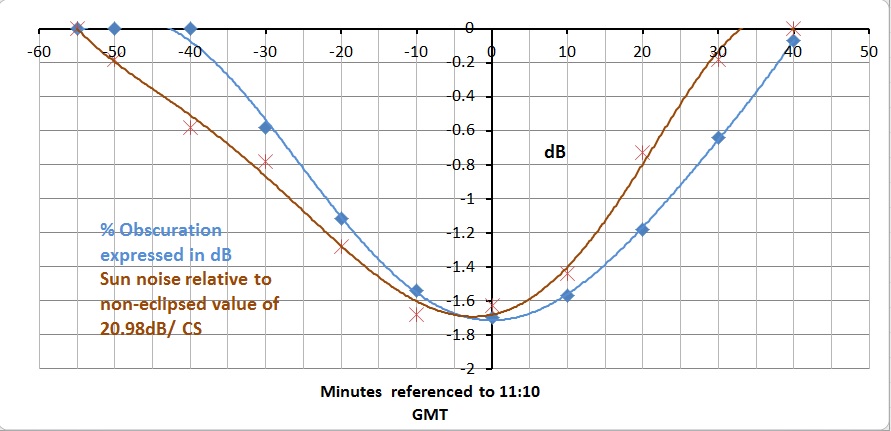 G3LTF eclipse 29 03 2025
G3LTF eclipse 29 03 2025
G4CCH Howard
27 March - 13 cm: DL3WDG CW #140, DL3WDG Digi
02 April - 23 cm: RW9OG digi #665, OL730PLZ (=OK1USW), OE3JPC
03 April - 23 cm: W4ATC, OH2DG, RY4C digi #666
04 April - 23 cm: BA7LOK digi #667, G3LTF on SSB, WA6RLR digi #668
Dubus VK3UM Memorial Contest - 23 cm
Worked 50 CW stations with 42 multipliers. Was only playing, not a serious contest effort. Did not stay up late, getting too old. Also made a few QSO’s on digi mode.
05 April - DU3T, PA3DZL, JA8ERE, DL7UDA, OK2PE, OH1LRY, F5KUG, DF3RU, OK1KKD, SP3TLJ, BH6BEZ CW Initial #577, F5JWF, F6ETI, W4ATC digi, ON5GS, DL1AT, OM4XA, SM2CEW, OH3LWP, IK2DDR, IK3COJ, SM3BYA, SP3XBO, DO1OS dig Initial #?, CT1DMK, IK3MAC, KA1GT, SP6JLW, VE6BGT, LA3PNA, SP9VFD, G3LTF, NQ7B, F6KRK, VA7MM, PI9RD, WA6PY, VE6TA.
06 April - R1MC digi Initial #669, OZ6OL, A71AW digi Initial #670 and digi DXCC #134 Qatar, FX1A, IZ1BPN, DJ3JJ, OK1DFC, OK1VUM, SV3AAF, IQ2DB, WA9FWD, CT1FGW, I5YDI, SP6GWN, K5DOG, G0LBK, WB8HRW, OE9ERC, KD2XN digi Initial #671.
07 April - KA1GT digi Q65-15A. 11 April - G1YLB digi. 21 April - HD8G = Bruce PY2BS on Galapagos Is. 2.4 m folding dish, 200 W for digi Initial #672 and digi DXCC #135 (With Moon at 11 deg elevation and obstructions close to the dish)
Martlesham Microwave Round Table
Travelled down to the Martlesham RT on Sunday 13 April (3 hr drive each way) but really pleased I went. Met with Peter G3LTF, Jac PA3DZL, Jan PA3FXB, John PA7JB, PA3AXA, Dave G4RGK, Jonathan G4KLX Sam G4DDK and John G3XDY. Had all my LNA’s checked out on their NF measuring equipment for reference. All were close to what I expected, but my 6 cm LNA’s were all below par, so I need to do some work to improve them, or find suitable replacements.
WSJTX 2.8.0
Updated to latest version with QMAP and posted to Live CQ for the first time. Spent some time setting frequency offsets in QMAP so that reported frequency was correct. Seems to work well. Did not see any Q65-30b in QMAP, this was working in previous versions. Will pay more attention next time.
Will be on 9 cm for the next leg of the Dubus Contest on 3rd May.
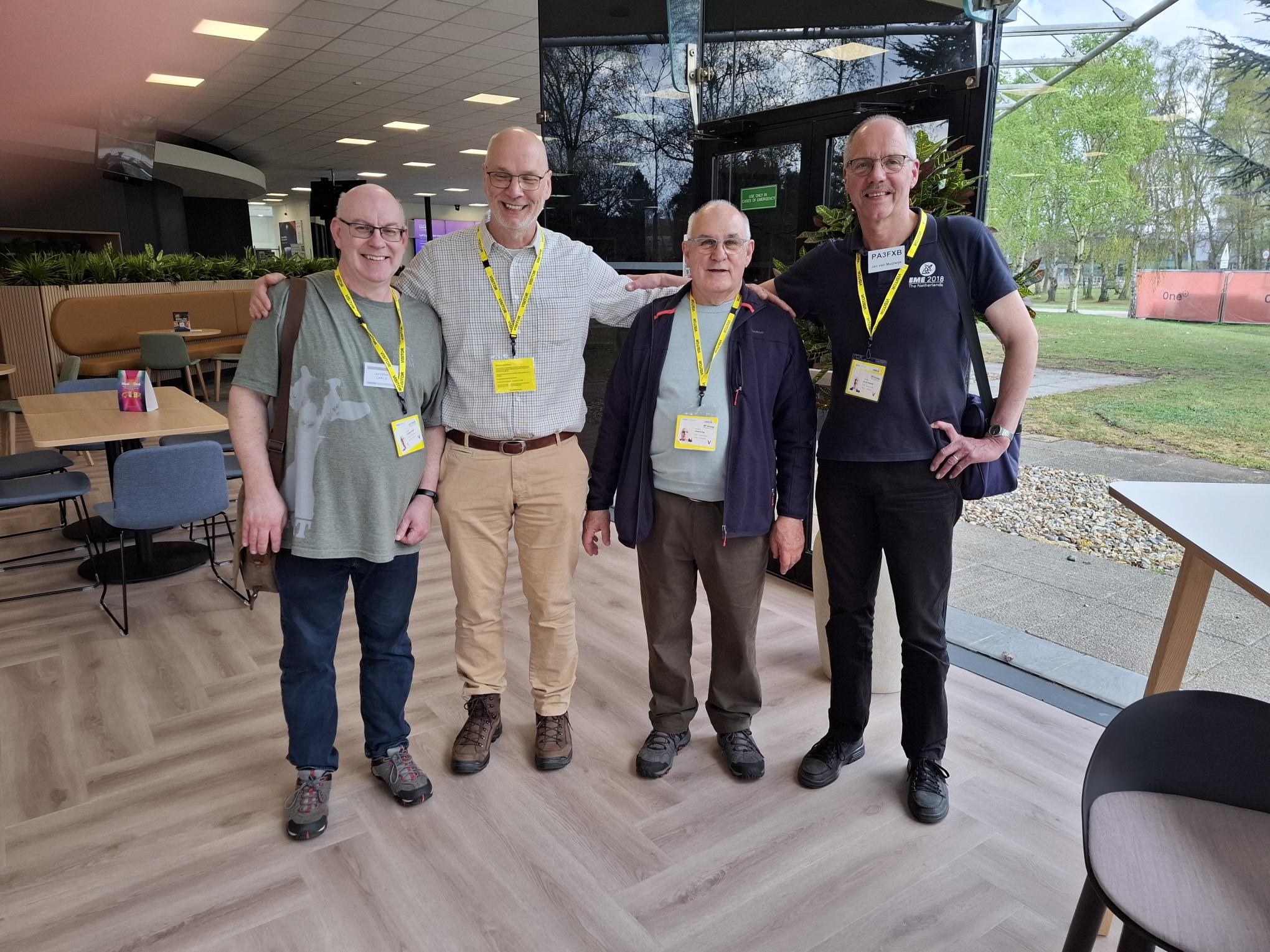 G3CCH Martlesham RT - Jonathan G4KLX - John PA7JB - Howard G4CCH - Jan PA3FXB
G3CCH Martlesham RT - Jonathan G4KLX - John PA7JB - Howard G4CCH - Jan PA3FXB
G4DDK Sam
With the six visitors from the Netherlands coming over to the Martlesham Microwave Round Table for the Saturday evening dinner before the main Sunday event, it was decided that a 'tourist' trip to Felixstowe (JO01PW) was a nice way to spend a gloriously sunny Saturday afternoon. The first port of call was the Victorian-era sea front shelter that I use for 24 GHz portable operation. With a WiFi port just a few metres away in one direction, a cafe less than 100 metres in the other direction and cover from the (frequent) summer rain, all that was missing was a toilet. That was 200 metres away!
The shelter is right on the sea front and has an uninterupted view towards the Netherlands, Belgium and part of France, plus the UK North Foreland. After admiring the shelter we all went off to a local, well-regarded, fish and chip restaurant, just 500 metres further away. There is a theme developing here ...
To walk off the lunch the group were taken for a walk along the Landguard Nature reserve, running along the foreshore. That allowed a close examination of the Haven ports (Felixstowe and Harwich) shipping radar, the Victorian Landguard fort and the container port, with the MSC Isabella 399 metre long container ship being loaded a very short distance away. This was then followed by an ice cream at the View Point Cafe. The theme continues.
With our visitors duly fed and watered we came back to my home QTH, in a nearby village. I have previously worked several of the guys on EME, so they were keen to see my EME dish and shack. See pictures. L-R WA5VJB, PA3FXB, PE9GHZ, ON/PA0MHE, G4DDK, PA3AXA and PA7JB (photo by PA3DZL). And finally back to the hotel for dinner!
 G4DDK PAs visit G4DDK QTH
G4DDK PAs visit G4DDK QTH
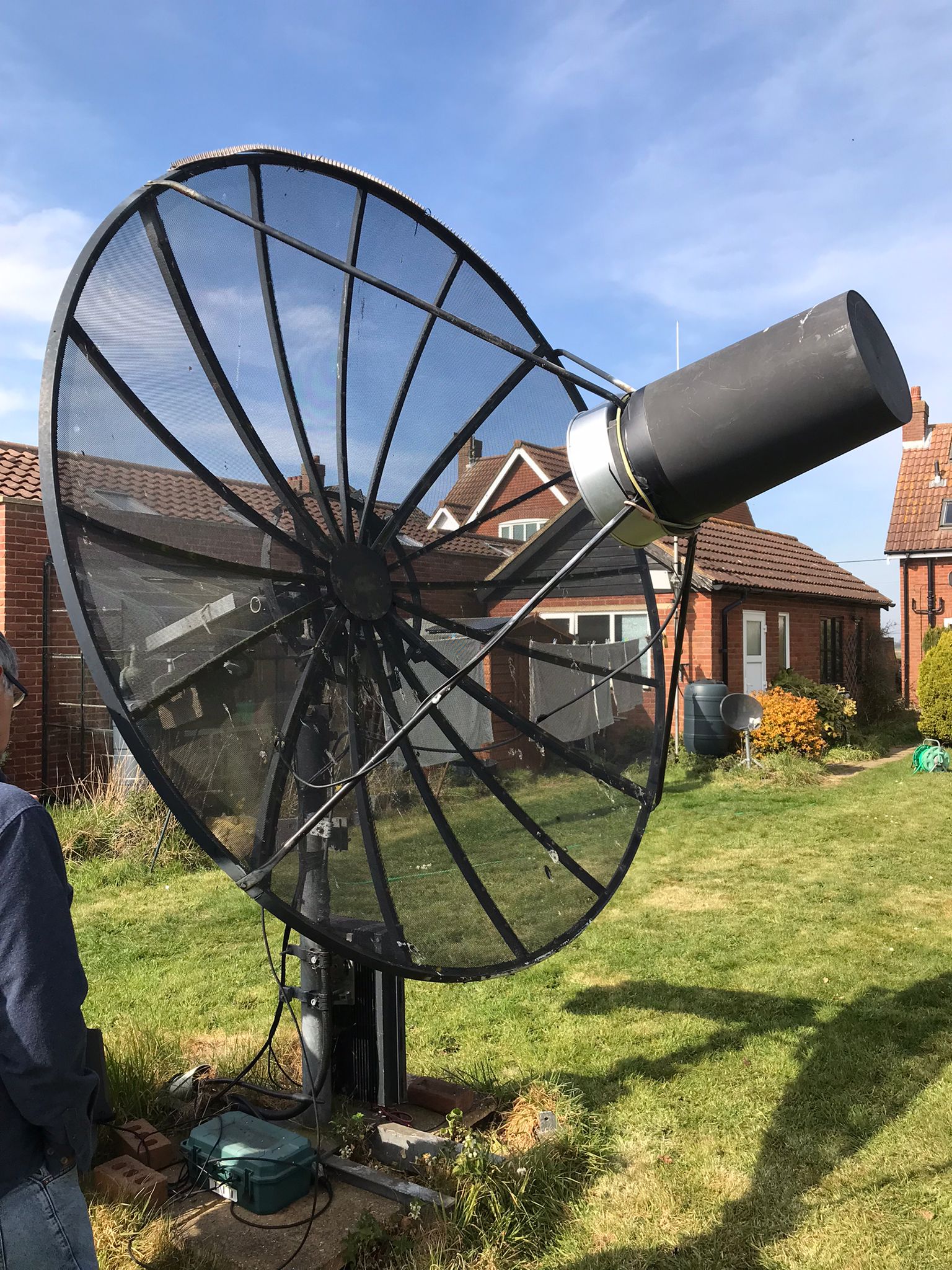 G4DDK 2m3 dish with 23cm feed
G4DDK 2m3 dish with 23cm feed
G4KLX Jonathan
It seems that the end of Winter has allowed for many EME stations to defrost their equipment as the amount of 23 cms EME activity over the past couple of months has dramatically increased. This has been reflected in the number of QSOs and increase in the number of initials I now have. I missed out on Alex EA8DBM's DXpedition activity due to my limited moon visibility, particularly to the east. In most cases he lost the moon thirty or more minutes before I gained mine.
Despite this my initials tally has gone up to 154 with a mixture of CW and Q65. A number of Q65-15A QSOs were made, but I find that WSJT-Improved appears to lose all receive sensitivity after a few minutes. So I only use it for 15A and revert to standard WSJT-X for all other operation. I've made no hardware changes since December, but I am now getting quite skilled at optimising my dish pointing which may have gained me a little. I now find that I can receive OE3JPC with his dual yagi system a lot of the time, which is very pleasing.
Since my last report the initials I have worked on either CW or Q65 are: SV3AAF (#110), NY1V (#111), ZS4TX (#112), DL3WDG (#113), IK7EZN (#114), OH3LWP (#115), LB6B (#116), KD5CHG (#117), DK0ZAB (#118), SA6BUN (#119), DM9LSB (#120), SP3XBO (#121), CX9BT (#122), OM4XA (#123), XE1XA (#124), W3TI (#125), VE6TA (#126), N6RZJ (#127), AC2AC (#128), I5YDI (#129), UA3MRE (#130), OE9ERC (#131), OL730PLZ (#132), G4RGK (#133), UN6PD (#134), RX3DR (#135), DK5AI (#136), DJ3JJ (#137), KN2K (#138), KD2XN (#139), BA7NQ (#140), OK2AQ (#141), OK1KKD (#142), ON4QQ (#143), G3LTF (#144), SP3TLJ (#145), PI9RD (#146), SP6JLW (#147), W4ATC (#148), SP9VFD (#149), IK3MAC (#150), GM0PJD (#151), LA3PNA (#152), PA0PLY (#153), W3SZ (#154)
On CW I have worked G4CCH, G3LTF, OK1DFC, SP6JLW, SP9CFD, IK3MAC, with the latter four being during the DUBUS contest. I heard but didn't work OK2DL and PA3DZL in the contest also. Not having worked very weak CW for many years I found it very hard going despite having access to good CW filters.
My equipment remains 300 Watts to a 2.4 m dish. I've documented my system in more detail at https://wiki.oarc.uk/member-projects:g4klx-23cms-eme
G4RFR / G3YGF Julian
On Weds 2nd April, on 10368 MHz we worked SQ9ATC -19/-6 (1m/10W), ON5TA -7/+3 (2m4/30W), G4HSE -17/-4 (1m2/10W), KM0T -7/-1, best-6 (1m8/60W), IK0HWJ -2/+1 (3m/100W), ON4CDU -13/-4 (1m2/25W) and CT2GUR -7/-1 (2m3/40W).
Unfortunately, we were not able to be on for the 5th April 1.3 GHz contest due to car problems.
On the 16th April we arrived to find our mains was off again! However, using a portable generator, on 1.3 GHz we measured about 13.5 dB of sun noise with our preamp, and 15 dB with a G4DDK one, but we did have some trouble with instability and we may have to reduce the gain a bit. We now have a sequencer and a 100 W PA with 0.5 dB feeder loss, and we hope to be on 1.3 GHz for the afternoon of Weds 30th April.
IK1FJI Valter
In the DJ3JJ SSB event on April 4th I make only 3 qso's with PI9RD 57/57, IK2DDR 53/55, and OK2PE 54/55. I sent report to DJ3JJ Andreas. Friday not a good day, very low activity.
In Dubus contest I was QRV 3 hours Saturday and 3.5 hours on Sunday until my elevation safety switch came in at 60 degrees. After October 2022 damage I pay much more attention to securing my dish. I had QSO with 38 stations: new initials were: FX1A #173, DL1HAH #174, OH3LWP #175, F6KRK #176 CW.
My station: 3.8 meter dish, rx sglab transverter to IC-7400 IF, Spectran version 2; 35 db 0.25 NF LNA, TH327 giving 1300 watt at feed, (see picture.) If weather will be OK I will be on in ARI EME contest.
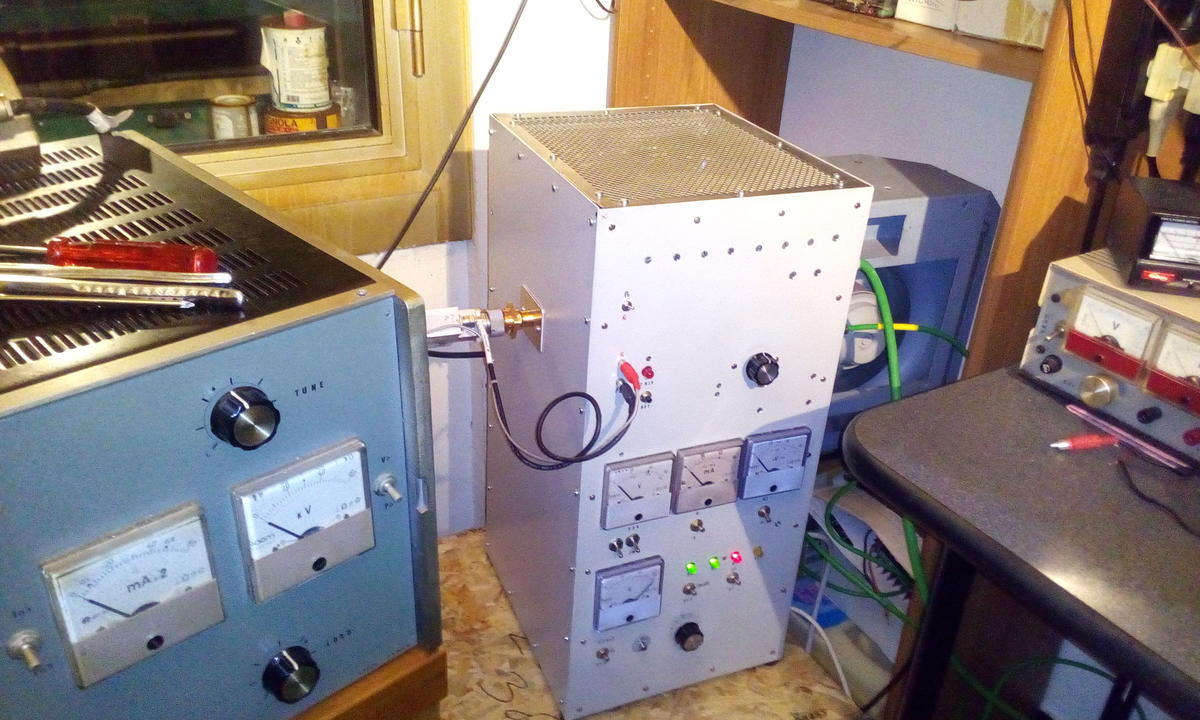 IK1FJI TH327 amp
IK1FJI TH327 amp
IZ0JNY Ivan
I renewed the EME setup at 24 GHz, making a new layout and changing the waveguide switch. I took advantage of this to install a 3-axis focusing system that is fast and precise. The slides can be moved quickly along 3 axes simply by loosening a couple of bolts, while for fine adjustment I can act on micro-metric screws.
A better focus of the feed allowed me - in 24 GHz - to go from 7.3 dB of SN and 2.5 dB of GND respectively to 8.6 dB of SN and 3.1 dB of GND, always with a 100 cm disk. This mechanical platform / support is the same on which I normally install my 3 EME setups: 10, 24 and 47 GHz, making everything very easy to mount and exchange.
For more information: https://www.iz0jny.it/24ghz-setup/
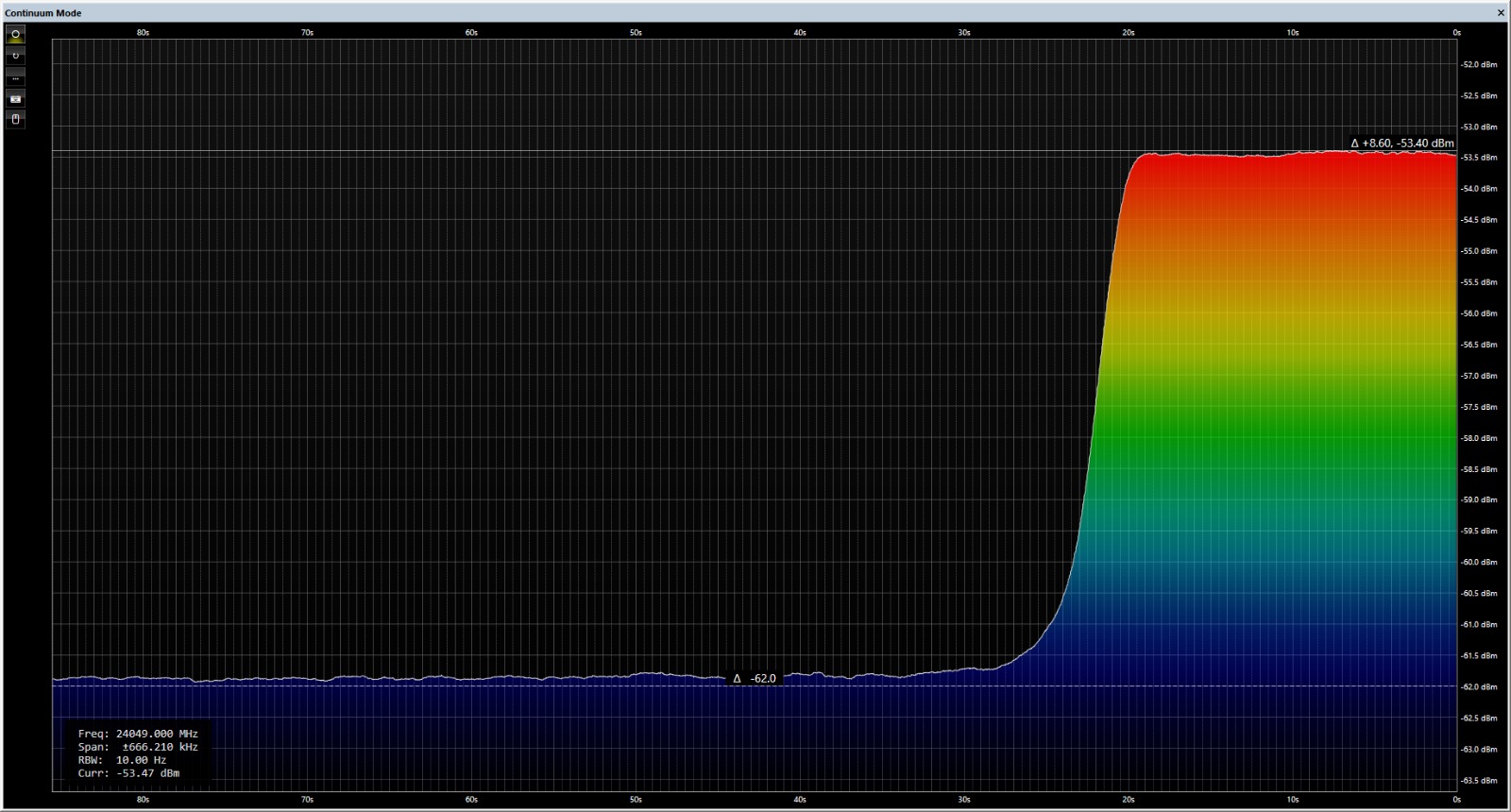 IZ0JNY 24GHZ sun noise
IZ0JNY 24GHZ sun noise
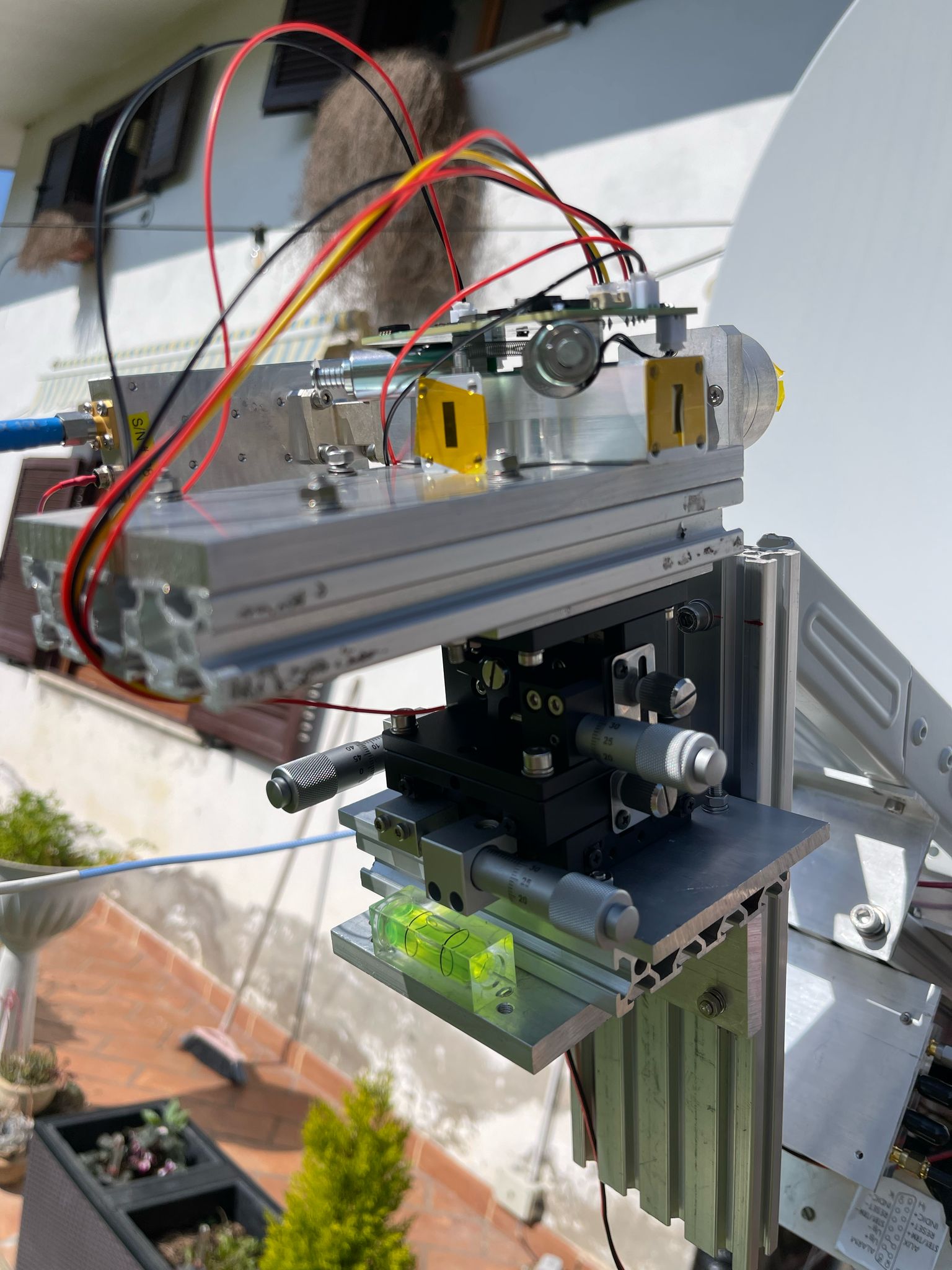 IZ0JNY precision feed adjustment system
IZ0JNY precision feed adjustment system
KA1GT Bob
I'm continuing to work on issues related to Rx performance including elimination of RFI (both spurs and broadband noise) and minimization of LNA front end losses. With the 3.1 m dish. Using drift scans, I can now see 23 cm moon noise, and signals from Taurus A and the Cygnus A region. Ground noise can be up to around 8.8 dB with ambient temperature around 273K (0C). During drift scans I frequently see a rise on the noise floor due to Galileo L6 transmissions passing through the beam as I have written about in the past - https://bobatkins.com/radio/galileo-1296.html. These can reduce decode sensitivity by 2 or 3 dB and unless you are looking at the noise floor and recognize the Galileo signature, you may not know this is happening. It will still occur at 1298, but at probably a slightly lower level.
Tests using Q65-15A with WSJTX-improved 2.8.0 - which can decode Q65-15A EME signals - have been quite successful, with around 25 stations worked, and over 35 QSOs. Single period decoding is quite reliable down to at around -20 dB without AP and down to -22 or -23 dB when AP is used. I would encourage even smaller stations to try Q65-15A on 23 cm. It does not require a large station. I'm running a 3.1 m dish and around 240 W. The smallest dish I've worked was 1.9 m. Stations worked recently (as of 07 Apr 2025) include KB2SA, W2HRO, W3TI, G4YTL, G4KLX, IZ4VSS, AC2AC, OL730PLZ, RA4HL, W3SZ, KG0D, G4CCH, DL3WDG, IZ8GGF, DL8FBD, PA3JRK, PA3DZL, DL1SUZ, OK1KIR, G4KLX, AB6A and YU1SAN (apologies if I worked you and you are not in the list). In one 8-minute period I completed 5 QSOs, and that includes CQ calls. With 60C that would have taken around 30 minutes, assuming everyone was prepared to wait around for "their turn".
Clearly Q65-15A is a viable mode for 23 cm EME and I hope to see it being used. It should be very useful for DXpeditions and rare stations working pileups and for contest operation at times of high activity. At the very least it could speed up working the stronger stations, giving more time to switch to longer modes and work anyone running QRP. For more details on 15s modes for EME see https://bobatkins.com/radio/Q65_15second_modes_EME.html
KB7Q Gene
I was active on 23cm again in April. I worked three new stations with my 2.4 m dish to bring my station count to 192. New to me were OE9ERC (-11/-13), AC2AC (-24/-25), and IU4MES (-27/-28). In addition, I worked SM6CKU (-14/-14), NC1I (-14/-12), K3SK (-24/-25), W2HRO (-21/-21), OK1KIR (-14/-11), OK1VUM (-20/-20), KB2SA (-19/-28), GM0PJD (-21/-20).
While I got the new slew drive wired up and working quite well with my Green Heron RT-21 box and PSTRotor tracking software, my tripod quickly let me know it wasn't up to handling the 22 kg mass of the drive along with the dish. Everything was quite wobbly (technical term). A local machine shop welded up a stout steel pier for me (see picture) and I'm in the process of drilling the mounting holes and painting the mount. I did use the slew drive enough to know it is a substantial upgrade - I can't wait for some north declination to wring out the station. I have a new AG6EE pre-amp to test!
 KB7Q mount and dish controller
KB7Q mount and dish controller
KD2XN Phil
March 27th marked the pinnacle of my EME journey - my 1st QSO was with Mats, KD5FZX – Q65-60C (-10/-13)! As of April 6th, I’ve completed 29 initial QSOs including 13 DXCC entities! My first 10 QSOs – KD5FZX #1(-10/-13), #2 NC1I (-4/-7), #3 AC2AC (-20/-22), #4 K3SK (-22/-23), #5 W3TL (-21/-22), #6 KG0D (-19/-22), #7 W2HRO (-12/-17), #8 LA3EQ (-20/-21), #9 OK1VUM (-11/-14), #10 PA3FXB (-15/-15).
Many thanks to those first 10 EMErs! On April 3rd I also completed my 1st Q65-30B QSO with SM5DGX (-5/-11). Due to prior commitments, I only operated 1-1/2 hours during the VK3UM contest. (Phil, the DUBUS-REFcontests are for random CW operation not digital. Ed.) I worked 6 initials and 1 DXCC GM0PJD (-15/-16), G0LBK (-14/-14), OK2AQ (-26/-23), AB6A (-20/-24), G4CCH (-10/-11) – see screen shot, and LA3PNA (-19/-23). All digi QSOs using a 2.3 m dish, septum feed with choke and 200 W at the feed using a vhfdesign.com 300 W SSPA. I have a 600 W W6QPL pallet in the works and will be QRV this spring. Looking forward to many more QSOs! See my QRZ.com page for station information. Hope to see you off the moon!
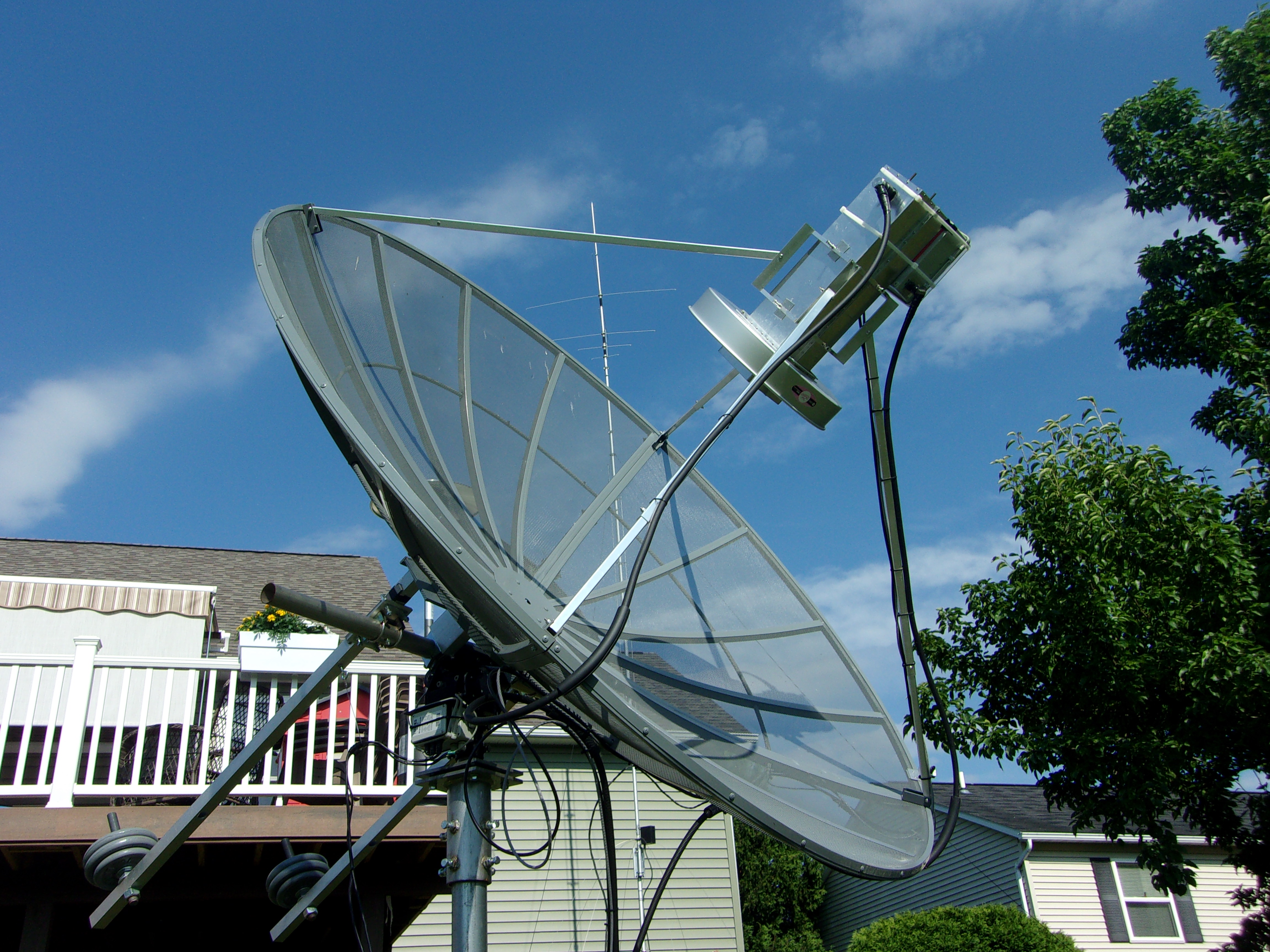 KD2XN 2.3 m dish
KD2XN 2.3 m dish
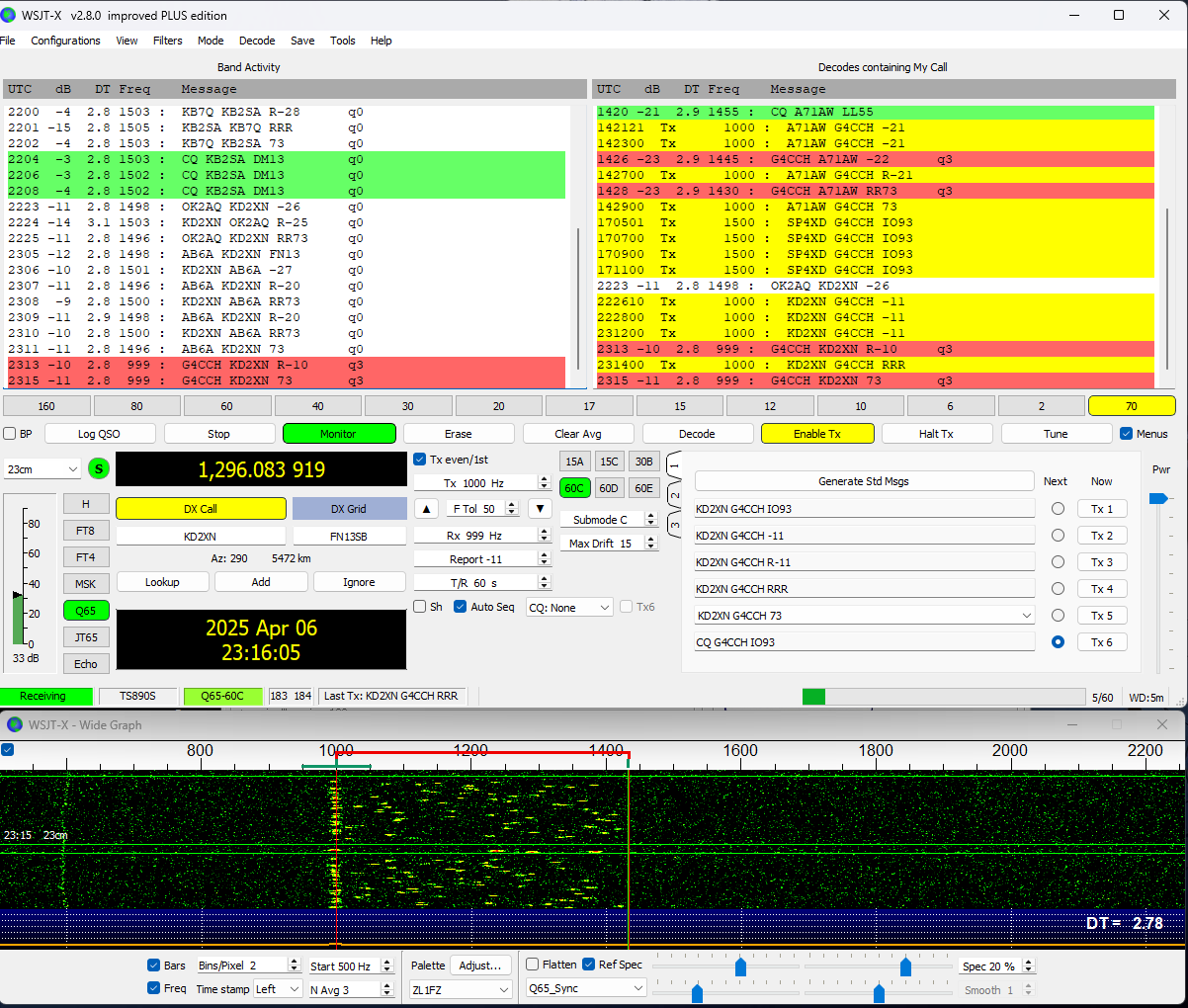 KD2XN WSJT screen
KD2XN WSJT screen
N1AV Jay
It has been several months since I posted anything in the newsletter, busy working on fixing bands and adding new ones to the back yard.
First, congrats to OK1DFC on his ARRL EME contest SOAB (Single Operator, All Mode, All Bands) win. I am looking forward to the competition again next year. I did my best on 7 bands, but just came up short. Well done Zdenek.
Second, I am happy to report that my 10 GHz EME station is now operational and working well. 1.8 m dish and 25-50 watts. A big shout out to Mike KM0T for all of the emails and texts, as my station is a sister station to his, albeit, not nearly as nice. I would love to run skeds with anyone who wants to try. In the past month I have worked: W4AF, CT2GUR, G4HSK, VE4MA and KM0T. I hear the EME beacon around -7.
Third, A big thanks to Bruce, PY2BS for operating HD8G on 1296 EME on the recent expedition. Well done. I appreciate you staying up late / early to work us out in the western part of the US, for us the very early hours of the morning.
See you all on the moon!
N5BF Courtney
On April 4, 2025, set up the folding dish in the back yard with the new 600 watt 23 cm amplifier just beneath it on the picnic table, driven by IC-9700. The system worked. I was seeing echos and working digital stations by 2200Z. April 5, 2025 from 0120Z to 0400Z, scanned the 23 cm CW band (1296.000 to 1296.050 and above), including a half hour CQ session. On the next moonpass, I operated similarly from 2300Z to April 6, 2025 0205Z before tearing down the station. Nothing heard or seen in the waterfall on CW in either pass except for local uplinks. I had read online of an equipment failure at KL6M, who would have been an easy QSO during my moon visibility, but since DUBUS prohibits live coordination, had no way to tell during these passes whether anyone else was even active on the band. I will be interested to read the reports in this month's newsletter to see if I missed others who I should have been able to hear. I also have receive performance improvements in progress.
I was not on in the first slot but there were certainly a few big stations [OK2DL] on in the second, I worked DL4DTU at 23:08. (The rules do permit self spotting outside your moon window so you can alert people that you will be QRV - Ed)
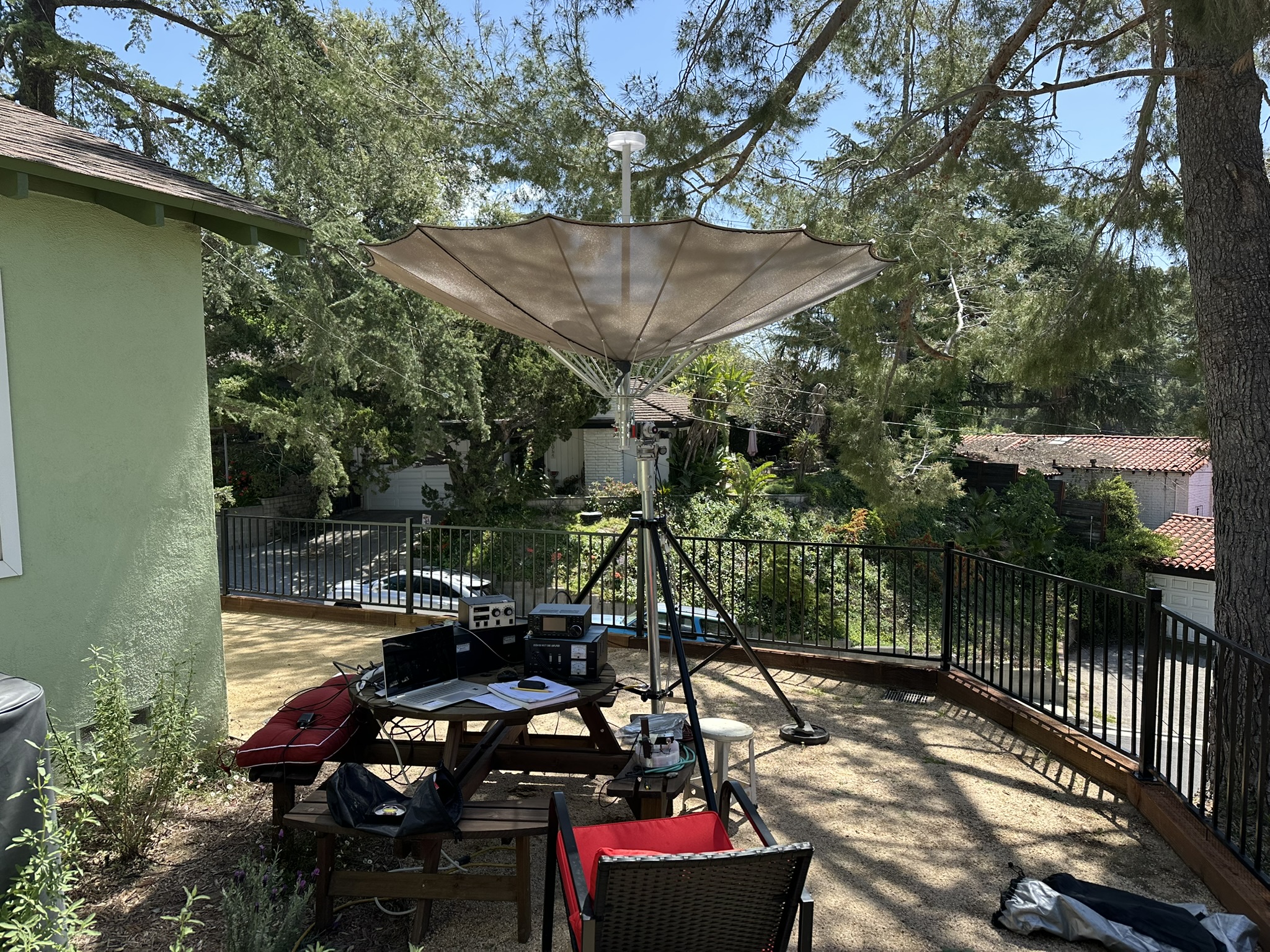 N5BF 23cm setup
N5BF 23cm setup
N9HF Dave
I have been off the moon for a while, but am now back at the 432 MHz WAS quest. The states I still need are: WA NV UT CO NM SD IA IL OH DE MD CT. If you can help me with any of these states please email me so we can set up a sked. I am available most any time. My station is 4x22 el and 400 watts. EL99JF (see https://www.qrz.com/db/N9HF for email - Ed )
NC1I Frank
I was not very active over the last month so I only added a few initials but did add one new DXCC on both 23 cm & 70 cm. Since my report last month, I have added the following initials: on 23 cm KD2XN (-07/-09) 2.4-meter dish and 180-watts and the HD8G DXpedition (-14/-08) for a new DXCC. On 70 cm I added initials with DF8JO (-27/-18) 1 x 23-element yagi and 50-watts for his first 70 cm EME QSO. DJ6OL (-15/-25) 1 x 23-element yagi and 500-watts for his first EME QSO. PA3CMC (-08/-11) 1 x 23-element yagi and 400-watts. And the A21TX DXpedition (-17/-22) for a new DXCC. I had worked A22BW several times back in the late 90s but had lost his QSL card so Botswana was not in my current 70 cm DXCC total.
Thanks to both the HD8G and A21TX groups for new DXCCs and a job well done!
OH1LRY Janne
At the beginning of the contest wind was problem again. Our 8 m dish is located to very open field with only minor wind protection on north side. Obviously open field is good for Moon visibility, but not so good for wind protection. Winter in Finland has been very easy for the dish and operators. Snow levels has been low or no snow at all most of time. In other hand wind levels has been higher than usual I think.
This time Petri OH3MCK was the only operator and we were on air only on Saturday. Petri worked 42 QSO's in total. 41 QSO's at 1296 MHz and only one at 1298MHz. Due current regulations in Finland we need to use small power at 1296MHz and we can use high power in 1298MHz (with +15 deg elevation and +30 dB gain). We tested a new 23 cm PA. PA has MRF13750H and PWB from Anders SM5DGX. PA was working fine. We hope that more stations will work us at frequency 1298 MHz in near future.
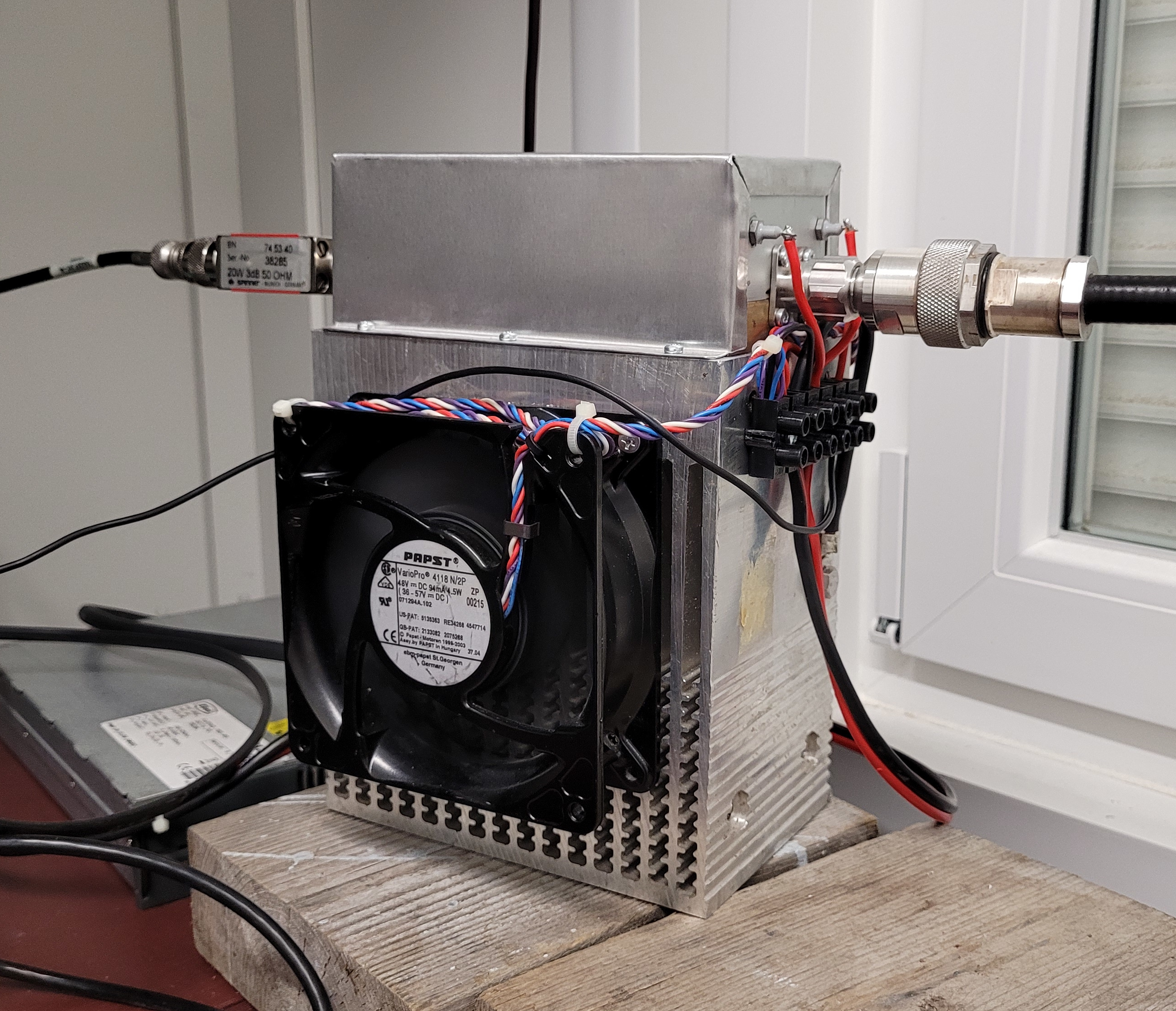 OH1LRY 23cm PA 2025
OH1LRY 23cm PA 2025
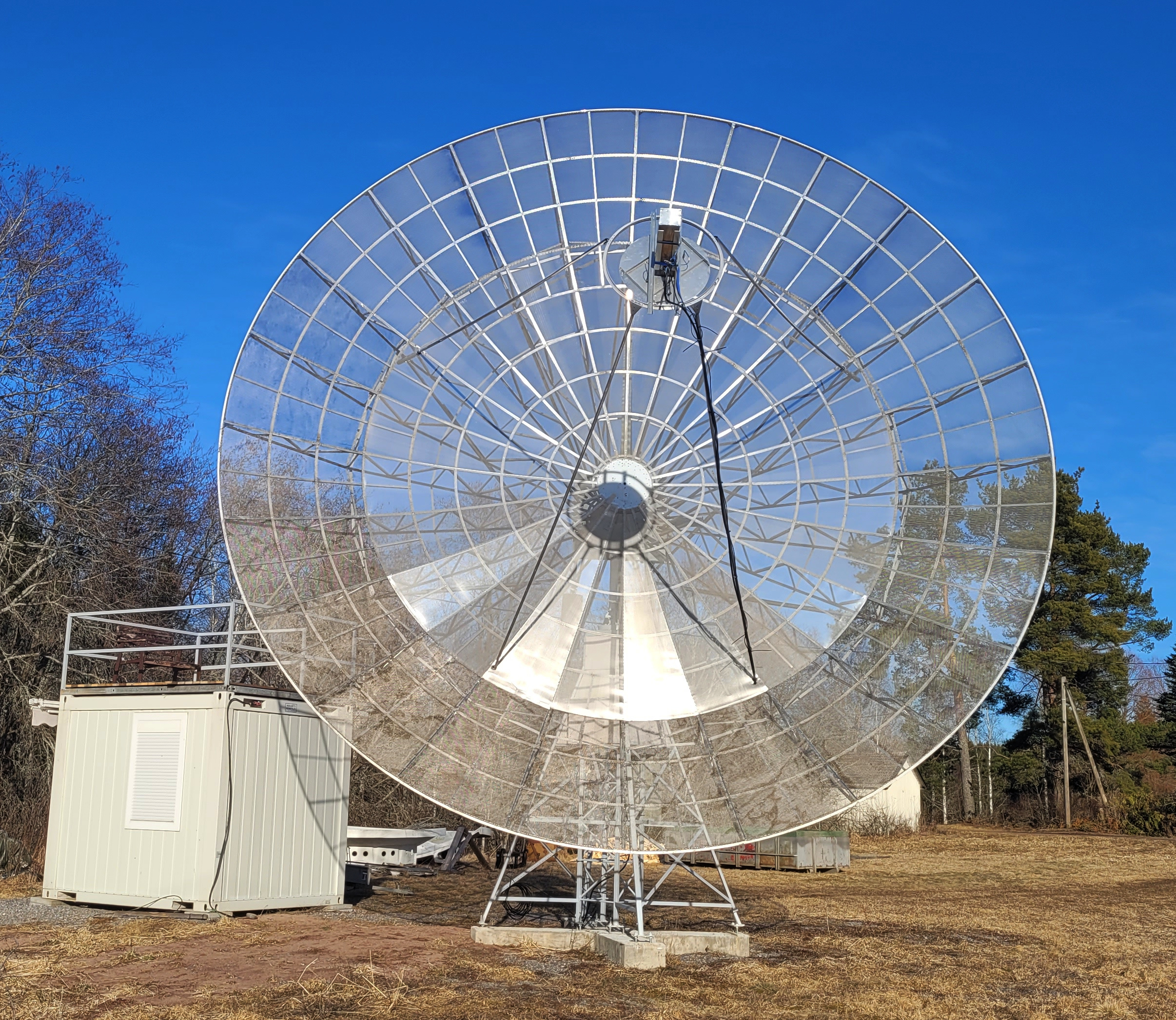 OH1LRY 8m dish
OH1LRY 8m dish
OH3LWP Ari
My new eme system with 4 m solid dish is now QRV on 5 bands 23/13/9/6/3 cm. I was active in 1.2 GHz DUBUS-REF CW/SSB contest both on Saturday and on Sunday. On Saturday had only 2-3 hours free, so most QSO listed below are from Sunday. All 32 QSOs random CW.
05/04/2025 OK1DFC, OK2DL, DU3T, SP6JLW, HB9Q, ON5GG, PI9RD, G4CCH, OH1LRY, SP9VFD, IK3MAC, 06/04/2025, OK1KKD, DF3RU, UA3PTW, G3LTF, PA3DZL, SM2CEW, FX1A, IK2DDR, IK1FJI, F5KUG, CT1DMK, OK1VUM, OZ6OL, WA9FWD, SP3TLJ, WB8HRW, WA6PY, K5DOG, NQ7B, VE6TA, OE9ERC.
OK1DFC Zdenek
I was looking forward to the contest and on Saturday morning before moonrise I took a measurement of the sun noise. The value of 22 dB said all was well on the receiving side and so I waited for the moon to rise. This time the window was quite favourable, as I don't like to stay up late. The moon rose after noon and set after midnight. Ideal condition and there was no need to cheat sleep.
So I set off as planned, with the stations slowly filling the log. By the time I had about 30 QSOs, I was starting to feel sick. Headaches and a persistent cough. Then I got chills so I got out of the hamshack and had hot tea, a bath and a bed. When I woke up after 12 hours of sleep, it was like being born again. I didn't understand what had happened. I took another Ibalgin (headech pils) just in case and waited to see what would happen. I felt fine, so I continued the work I had started on Sunday.
On Saturday, the conditions were very strange. I've been there before. The ionosphere was completely broken. Signals were coming in strangely distorted. If I hadn't done a sun noise test, I would have thought the RX was broken. Some signals weak, well readable, others strong chopped up so that I was composing the counter CALL only on the second or third call, sorry to everyone I was not able to read. Also, SM3BYA posted on the EME net that the Ionosphere was acting very strange on Saturday and was having trouble receiving stations. All in all I made 44 valid QSOs. It seemed to me that the CW activity on 23 cm band is also slowly fading. The band was full of stations with WSJT traffic, but on CW it was miserable this time. Where are the days when I made around 100 contacts in a DUBUS contest. Still, there were a few new stations and I improved my initials score. Thanks to all who called in and again next time. VK2JDS 539/559 #506, SP3TLJ 539/559 #507, FX1A 599/589 #508, DJ4JE 539/559 #509, OK1VUM 559/589 #510, DL3WDG 559/559 #511.
OK1KIR Vlada
Our activity during 23 cm Dubus contest was concerned on new initials and mainly on A7 DXCC. On Sat, Apr 5 we found on CW no one new initial and worked only SP3TLJ from SP3YDE radio club. On digi we worked with Q65-60C five new initials R1MC #617, DO1OS #618, RY4C #619, A71AW (20DB/17DB) #620 as new DXCC #140 in new field LL #93 (Hamad used new aerial system 4x56 el Yagi with 50 W in antenna) and the last new initial was WA6RLR as #621.
We also tested on 23 cm mode Q65-15A working KA1GT (WSJTX 2.8.0 needed for decoding) and with Q65-60C we worked OL730PLZ as special station for 730th anniversary of Pilsen as the town of known brewery (details on qrz.com). Further added Q65-60C QSOs with K6FOD, KB7Q and OK2AQ.
On Sun, Apr 6 after moonrise no new one was found and we went QRT later on. At 7:40 CasA was tested and we found noise increase of 1.2 dB.
Next event was expedition HD8G, originally awaited on 70 cm, but it appeared on 23 cm thanks to PY2BS with 2.4 m umbrella dish and 200 W. On Sun, Apr 20 we decoded Q65-60C signal from Bruce first at -19 dB on his Moonrise but our Moonset, which already added over 2 dB ground noise into our HPBW of 2.6 deg which licked our hilly south horizon close to Moon at 10 deg elevation. However, we worked HD8G at 06:14 18DB/16DB as initial #622, DXCC #141, new field EI #94 and #39 CQ zone for WAZ award (however still missing 34th zone – Sudan, Egypt, Libya). It was also 1st QSO HD8 – OK on 23 cm. Last decodes of HD8G signal gave still -24 dB at elevation of 5 deg when ground noise already contributed over 5 dB to the sky background.
OK2AQ Mirek
After winter we went to the cottage for the first time and since Wednesday April 2nd I started EME on 23 cm. My motive was the expected increased activity around the DUBUS contest. I wasn't going to participate in the actual contest as it is a hassle with my small setup (1.8 m offset dish, 200 W). Of course, I tried to listen to CW stations in the contest and I can confirm Zdenek's OK1DFC information that the stations were very hard to "read" this time.
Finally, I worked in CW only Marek OK2DL. On the other hand I really enjoyed the week. I managed 15 new initials OE9ERC, F5KUG, W2LPL, K3SK, AC2AC, G4KLX, IZ8GGF, BA7LOK, UA9FA, K6FOD, OE3JPC, WA3GFZ, KD2XN, JH3AZC, SP9VFD {#196} and 50 QSOs in total. It is gratifying to see how the digi traffic is cultivating. The vast majority of stations already use oscillators hung on atomic standard and therefore have accurate frequencies, understand the advantage of CFOM and can use AP or averaging. As a result, even small stations are working each other.
Using OZ9AAR's excellent SkyScanner program, I mapped a portion of my sky at 23 cm with an azimuth range of 75 - 300 deg and an elevation range of 10 - 40 deg. The HPBW of the antenna is 9 deg and the step in both axes is 10 deg. The image shows a strip of ground vegetation, a tree near the south direction and the Sun before setting. The program intelligently recalculates the dynamic range of the measured noise levels. For high resolution it is therefore advantageous not to see the Sun at the time of measurement (it can also be eliminated in the program settings).
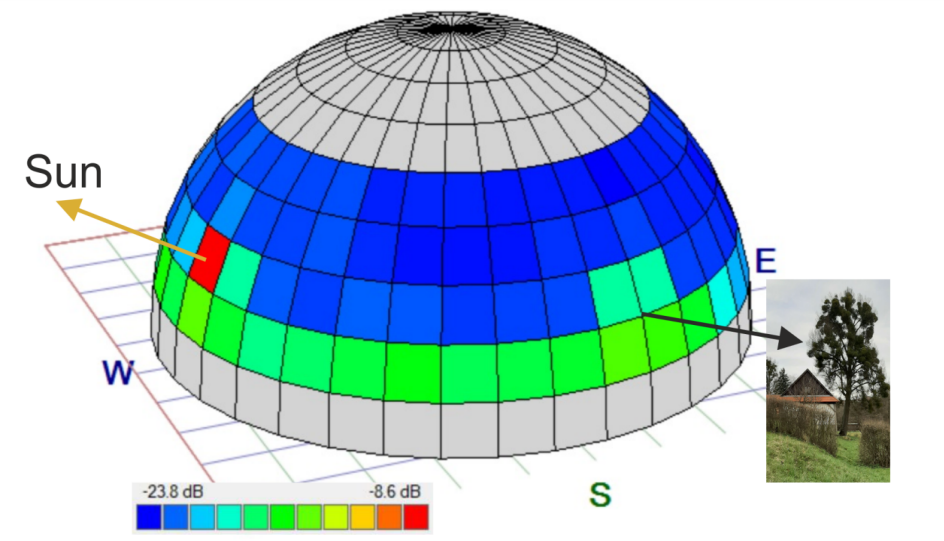 OK2AQ 23cm skyscanner plot
OK2AQ 23cm skyscanner plot
PA2V Peter
Not much to report this month - it is a bit worrying that even during perfect moon times activity is so low. During the last period with high declination and perfect times it was extremely quiet. Is 432 MHz EME slowly dying?
The PA6Y clubstation is quite active and we worked a lot of stations already. Please send QSL cards for PA6Y via the bureau. If someone require a direct card they can send it to me, but I need a SAE and some compensation for the stamp. Stamps for foreign mail is getting quite expensive. So, I need 2 euro to be able to answer PA6Y cards. Of course PA2V cards are for free, hi. My address is okay at QRZ.COM
PA0GRU did activate the station for one day with his own call. QSL cards are okay via LOTW. If one need a real card, it can be send to: Dick van Empelen, Richard Strauszlaan 21, 2102XL Heemstede, The Netherlands
PA3DZL Jac
During the Dubus CW/SSB 1296 MHz contest I made 47 QSOs with one initial in CW with SP6GWN #. On 1296 MHz I was also QRV in Digital mode and worked: DO1OS initial #, KA1GT in mode Q15A, this was an easy QSO, R1MC initial #, A71AW nice signals from Hamad in Qatar and LA3PNA initial #
1296 MHz On the 20th of April, the first day of activity from the Galapagos DX-Pedition, a very nice Digi QSO with Bruce, PY2BS operating as HD8G, his best was -20. This was a new DXCC # 114 for me.
SM2CEW Peter
During the winter I have not been QRV on 23 cm CW EME due to the snow and ice load on my 8 m dish, plus the fact that we had one storm after the other due to the weather pattern.
But for the VK3UM Memorial Contest the weather prediction looked ok so I decided to untie the dish on Saturday afternoon and started looking for stations on my moonrise which is heavily blocked by trees. Signals were down, but I suspected this was because of the tree blockage. To make a long story short, my suspicions were wrong.
I eventually realized that I had a problem with my receiver as I was struggling to hear stations that are normally easily readable here.
So on Sunday morning I took a good look at the receive chain and found a high NF issue that needed to be fixed. This restored the receive situation and made operating much more enjoyable on Sunday afternoon/evening.
The following stations were worked: on 5 April: G4CCH, ON5GS, SP3TLJ #, F5KUG, PA3DZL, IK2DDR, SM3BYA, OK2DL.
And on 6 April: IZ1BPN, IK1FJI, OK1KKD, SP6JLW, DU3T, G3LTF, OH3LWP #, G0LBK, IK3MAC, OK2PE #, CT1DMK, SP3XBO, SP9VFD, OK1DFC, G4RGK, OZ6OL, F6ETI, WA9FWD.
Now I need to make sure that no birds nest in my dish, feed or rotation system so I can be QRV a bit more often on random 70 cm / 23 cm CW EME
:-)
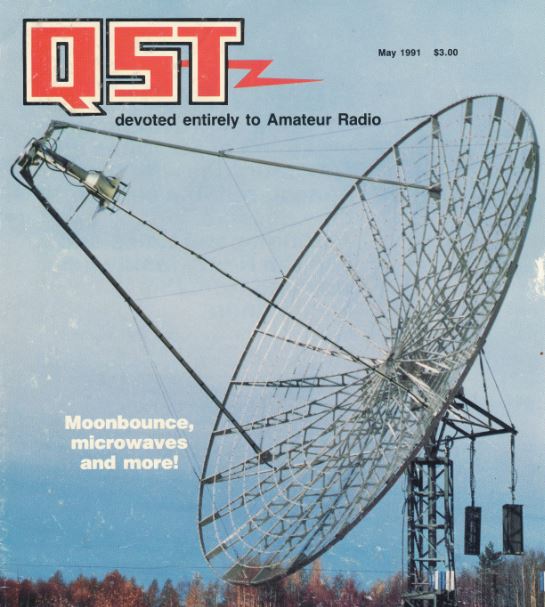 SM2CEW 1991 QST dish cover photo
SM2CEW 1991 QST dish cover photo
SM4GCC Stig
I have now completed my antenna system for 70 cm with 6 X 26 el YU1CF 10 WL yagis in horizontal polarisation and 4 X 24 el homemade YU7EF 9 WL in vertical polarization.
The first tests are done and it seems to work as expected with around 11-12 dB sun-noise in H-pol and 9 dB in V-pol. My first very early experience with only 19 QSO in a couple of weeks on V-pol at 70 cm is that perhaps 1 of 9-10 QSO has benefited from it, but certainly a longer test period is necessary.
QSOs worked from 30/3 to 8/4 2025 in Q65 on 70 cm: QO100R, K3KSK, W4YTB, W5EME, NY1V, DL8DAU, OZ9AAR, G0JDL, DL1VPL, DK0TE, PA2V, OZ9AAR, NC1I, W4YTB, DL8DAU, OK1JG, DC1RDB, OH3KJL and 7K3LGC. My TX-power is 400 W and RX is a Khune MKU LNS 432A at antennas. More at https://www.sm4ggc.se
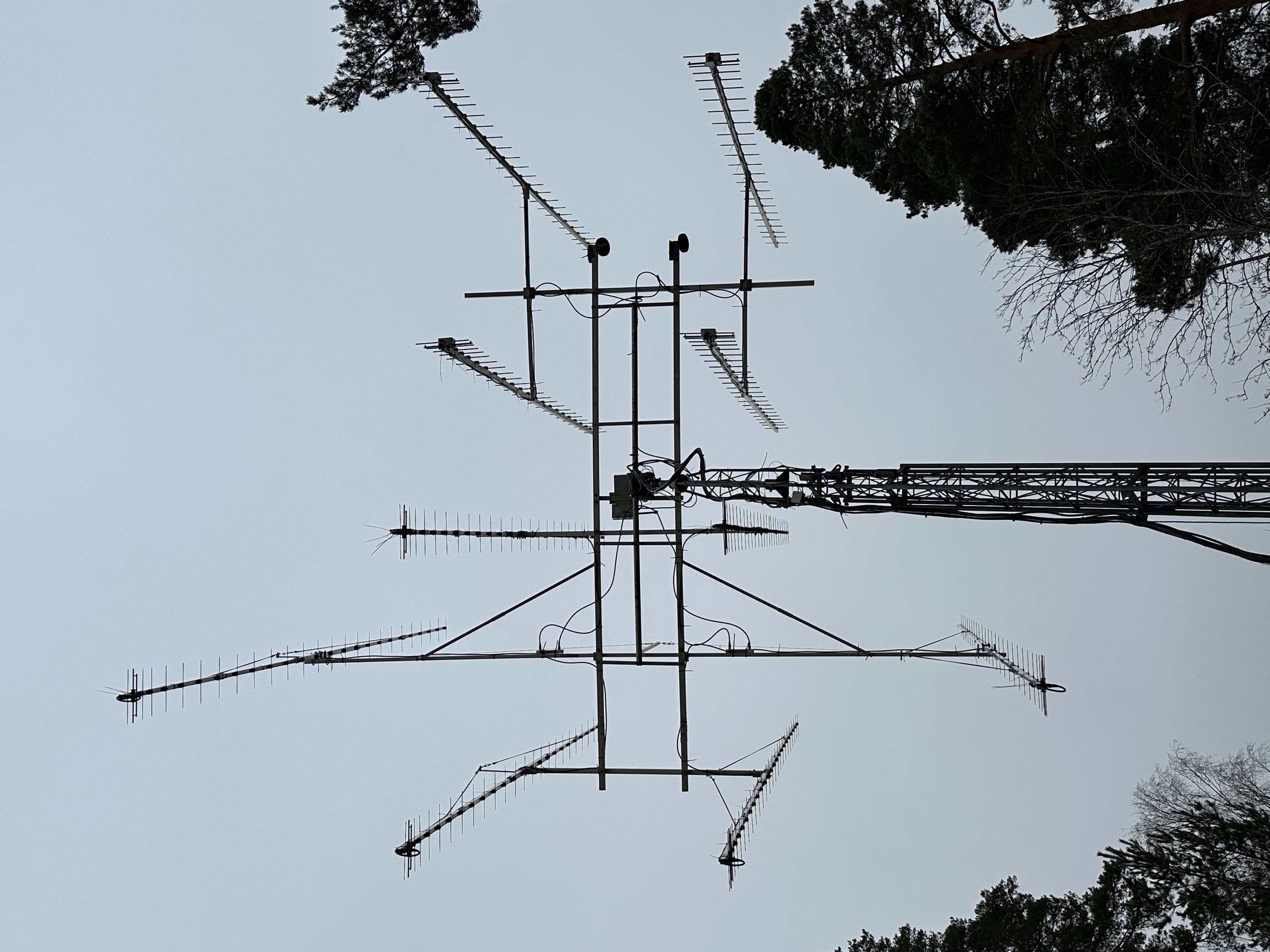 SM4GCC 70cm 10 yagi array
SM4GCC 70cm 10 yagi array
SP6JLW Andy
No activity on 70 cm, the power amplifier is still awaiting repair.
On 13 cm band: OH2DG, SP9VFD, OK1KKD, DL4DTU, SP3XBO, F5JWF, DL1SUZ, DB6NT, OK2ULQ, OM6AA, OH1LRY, G3LTF, PA0PLY, IK2RTI, OM1TF, SV3AAF, IK3COJ, G4CCH, PA3DZL, G4RGK, DL6SH, VE6BGT, ES5PC, VE6TA, WA6PY. 25 QSOs - 23 multipliers.
23 cm band: SP3TLJ, OK1KKD, DU3T, OH1LRY, PI9RD, OK2DL, G3LTF, SP9VFD, DL1AT, IK3MAC, PA0PLY, DF3RU, JA8ERE, SP3XBO, HB9Q, IK1FJI, PA3DZL, OK1DFC, F5JWF, XE1XA, OH3LWP, OK2PE, SM3BYA, CR5A, F6ETI, F5KUG, G0LBK, G4KLX, CT1DMK, F6KRK, IK3COJ, OM4XA, ON5GS, G4RGK, DL7UDA, I5YDI, WB8HRW, IQ2DB, CT1FGW, IK2DDR, G4CCH, VE6TA, VA7MM, NQ7B, WA6PY, XE1XA, VE6BGT, K5DOG, JA6XED, IZ1BPN, SM2CEW, DJ3JJ, OZ6OL, SV3AAF, OK1VUM. 55 QSOs - 44 multipliers.
Thank you to all our correspondents. Cu next time.
SP9VFD Raf
I was on for the Dubus EME 23 cm contest on April 5th/6th, weather conditions were pretty good. Unfortunately I couldn’t stay all the time in shack due to business obligations and probably missed someones. I worked CW random with following: PI9RD, SP6JLW, OK2DL, DU3T, SP3TLJ, OH1LRY, F5KUG, RA4HL, OK1KKD, G4RGK, DL1AT, PA3DZL, ON5GS, G3LTF, OM4XA, SM3BYA, SP3XBO, DF3RU, RX3DR, OK2PE, F6KRK, G0LBK, IK3MAC, OZ6OL, FX1A, DL7UDA, IK3COJ, G4KLX, IK2DDR, OH3LWP, I5YDI, IQ2DB, SP6GWN, CT1FGW, VE6BGT, NQ7B, WA6PY, VE6TA, VA7MM, G4CCH, K5DOG, CT1DMK, XE1XA, IK1FJI, PA0PLY, F5JWF, F6ETI, OK1USW, OK1VUM, SM2CEW, OK1DFC.
After the contest and before Easter I had worked on 23 cm Q65 with following: PA3FXB, SP3TLJ, F4DWB, PA1PS, UA9FA, OK2AQ, LA3PNA, PH0V, AC2AC, NY1V, DJ7FJ, IK3COJ, OH3LWP, UA9YLU
My current 23 cm setup consists: 640 cm dish, WD5AGO cavity LNA (0.27 dB NF, 35 dB gain), Power at the feed 500 W, Kuhne MKU 13 G4 23 cm transverter, Icom IC-9700 (144 MHz IF), SDRplay RSPduo.
I will be QRV Dubus 9 cm leg on May 3rd.
VE6TA Grant
I worked the following during the 23 cm DUBUS CW contest: OK2DL, NQ7B, OE9ERC, VE6BGT, WA6PY, VK5MC, DU3T, SP6JLW, IK3MAC, OK1KKD, G3LTF, SP9VFD, DL1AT, SP3TLJ, VA7MM, OH1LRY, G4CCH, F6ETI, DL4DTU, K5DOG, DF3RU, CT1DMK, OH3LWP, OZ6OL, WA9WFD, G0LBK. (Station is 18 foot dish CP feed and 700 w from W6PQL amp in the shack.)
Lots of QSB made copying weaker stations a bit of a challenge for me. I had a station call me near the end of the contest but unfortunately was
unable to copy the call. Overall some reasonable activity but missing many NA QSO's with only 6 in the log... (Same here, only 4 USA and 3 Canadian. Ed)
I was also QRV on 222 MHz EME with my 18 foot dish and homebrew feed. I worked K1WHS, NH6Y, W5EME and heard K3SK. I am looking to complete VUCC/WAS on this band as there are few 222 terrestrial stations active in my area.
WB8HRW Roger
In the recent DUBUS / VK3UM memorial contest I worked the following, all CW: SP6JLW, IK3MAC, OK2DL, OH1LRY, OK1DFC, DF3RU, G3LTF, OH3LWP, OZ6OL, G4CCH. I had several more get away, not able to copy my QRP signal after many repeats. I use a 3.8 meter dish, an old Icom 751, homebrew transverters, and a 2XMRF286 SSPA. Tracking is manual, using 1 and 3 turn precision pots and DPM readout. I can work digital, but it is tedious with my ancient setup. I like CW, and will never tire of hearing my weak echoes! (Me too! - Ed)
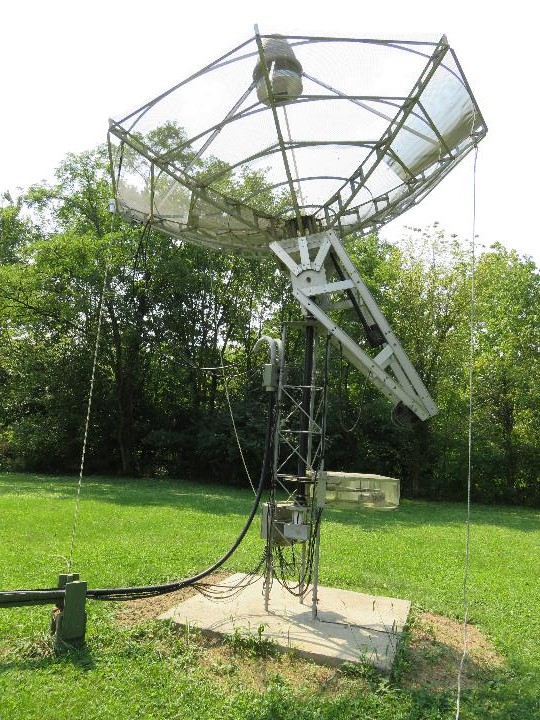 WB8HRW 3.8 m dish
WB8HRW 3.8 m dish
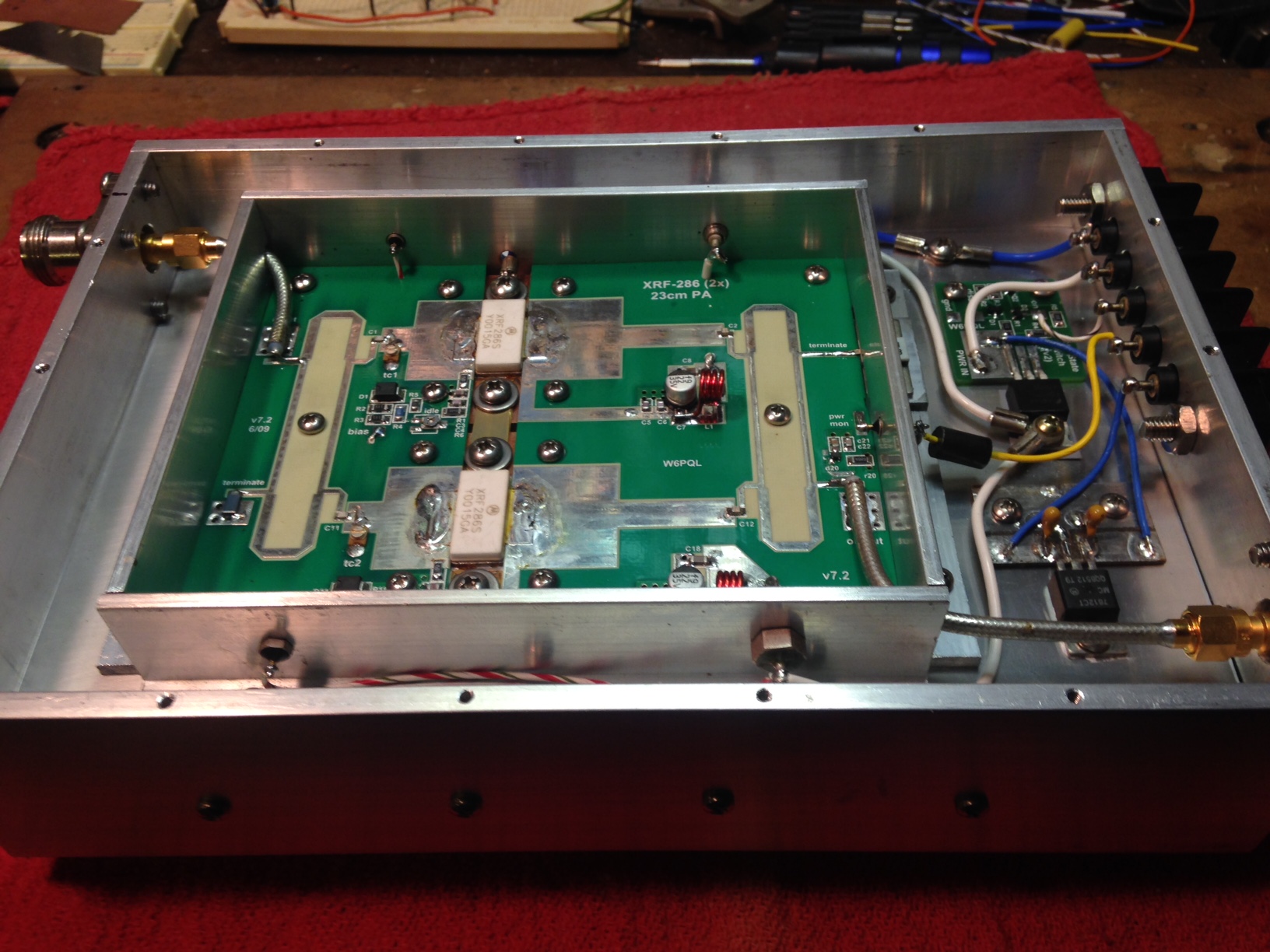 WB8HRW 23cm PA
WB8HRW 23cm PA
YO8RHI Adrian
In April I received my first DL0SHF 24 GHz EME Beacon! TNX Per.
My setup: New 2.2 m PF dish, 0.1 deg controller, PA0MHE Wavelab board and DU3T KLNA.
I am very happy with the results obtained and the relatively low cost. No GPS Do, only 10 MHz ocxo. In average decoders you will find low power beacon reception. I have now received the DU3T_WR42-WG-SWITCH, and the RX/Tx configuration will be changed.
I hope you can work YO in 24 GHz EME as well.
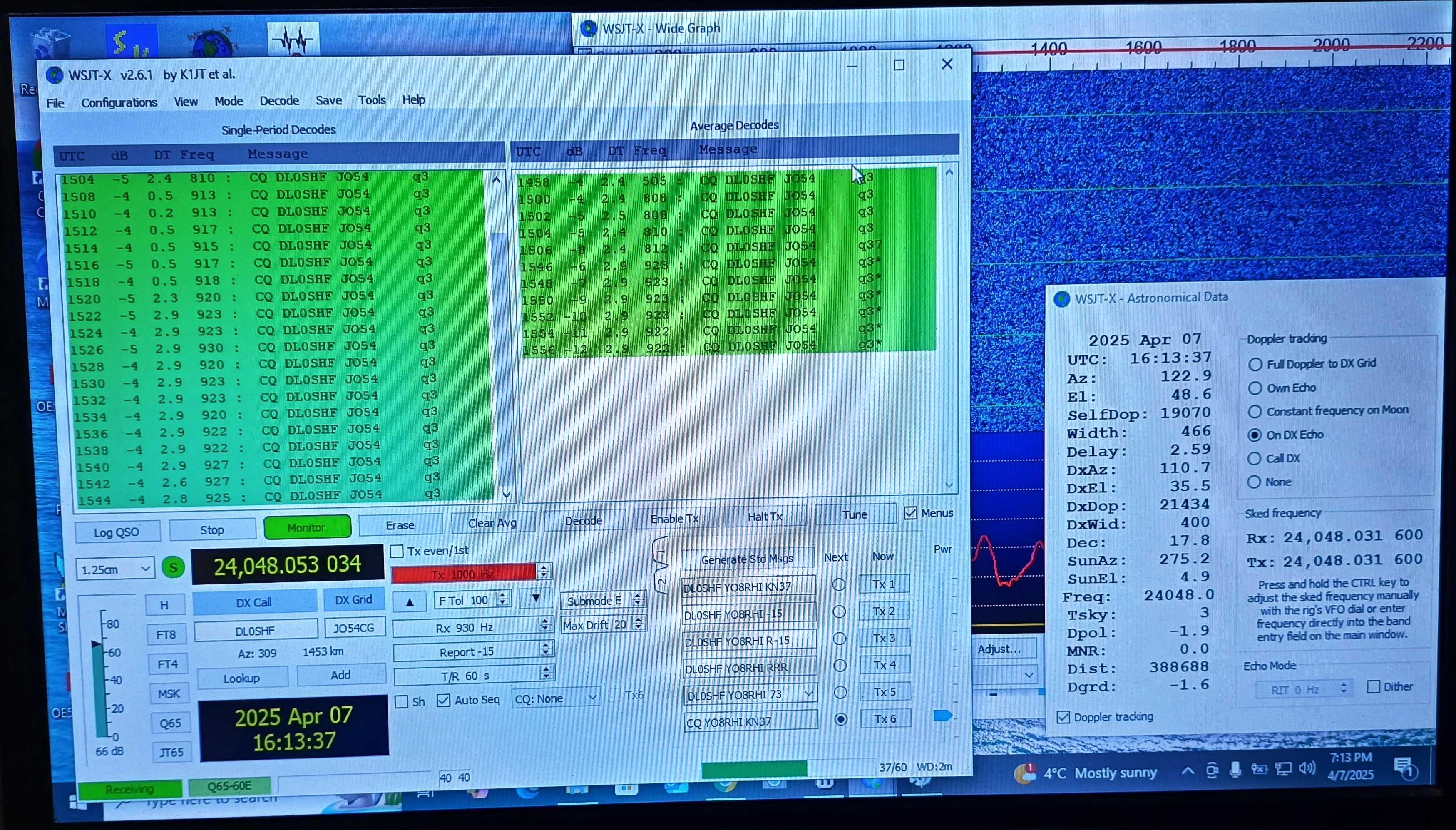 YO8RHI rx DL0SFH 24GHz
YO8RHI rx DL0SFH 24GHz
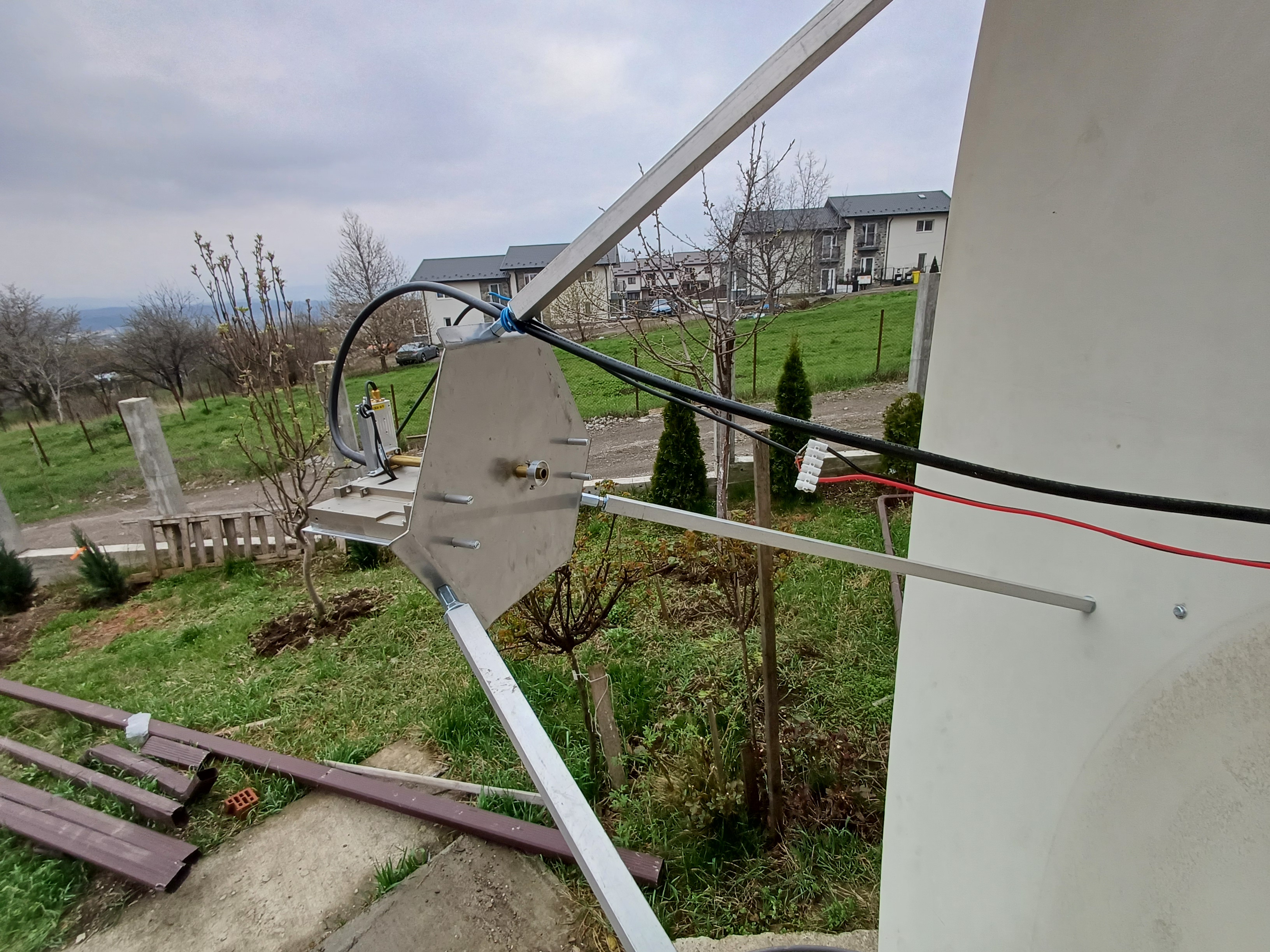 YO8RHI 24GHz feed
YO8RHI 24GHz feed
23 cm Feed Extension and Choke
KB2SA
Bill has published simple production techniques on Moon-Net for the square to round extension and choke for the optimal 23 cm feed for dish f/D between 0.33 and 0.36.
https://groups.io/g/Moon-Net/topic/how_to_create_a_square_to/112177299
https://groups.io/g/Moon-Net/topic/how_to_create_a_choke_for_a/112270514
One may begin with the new OK1DFC short (lightweight) square waveguide with slope septum or any similar square waveguide with a sloped or stepped septum. Although a cake pan was suggested for the optimal choke, an alternative lightweight wind-transparent 460 mm x 110 mm choke may be constructed from a wire mesh with an aluminum skeleton to help maintain the shape.
The entire waveguide may also be constructed using a round tube made from thin aluminum flashing or a wire mesh for wind transparency. The only difficulty may be how to mount the internal septum and a larger DIN connector if needed for > 600 W stations.
Moonbounce at Martelsham
G3LTF
 MRT meeting PA3DZL G0OLX G4CCH G4DDK PE9GHZ G3LTF G4LDR PA7JB PA3FXB WA5VJB
MRT meeting PA3DZL G0OLX G4CCH G4DDK PE9GHZ G3LTF G4LDR PA7JB PA3FXB WA5VJB
This meeting is organised by the UK Microwave group and this year saw a good number of moonbouncers in the total of 83 attendees, including G4CCH, G3LTF, G4RGK, G4YTL, G4DDK, G4KLX, G4LDR, G4BAO, GØOLX, G8RWG, PA7JB, PA3FXB, PA3DZL, ON/PAØMHE, PE9GHZ, and WA5VJB.
Jan, PA3FXB described the activities at PI9RD reflecting signals from various satellites and of course from Venus. Barry, G4SJH reviewed the regulatory challenges to the microwave and mmw bands in the WRC-27 agenda and also the Galileo situation following WRC-23. Peter, G3LTF described the history of the 432 MHz and above Newsletter and then moderated an EME Q&A session.
The discussion centred mainly on where the EME activity should migrate to from the current 1296 MHz, looking at the slide from G4SJH showing the Galileo guard band marked as ------
After discussion about the risks and possible consequences of interference if we positioned the EME band immediately adjacent to 1298 MHz the consensus of those present was that we should go 1 MHz higher to 1299.000 - 1299.150 MHz so as to be completely safe. G4SJH will take this view to the IARU Region 1 meeting in Paris on 26-27th April which will discuss the post Galileo band plan for all services in the 23 cm band.
G4SJH 1296-1300MHz slide discussed at Martelsham
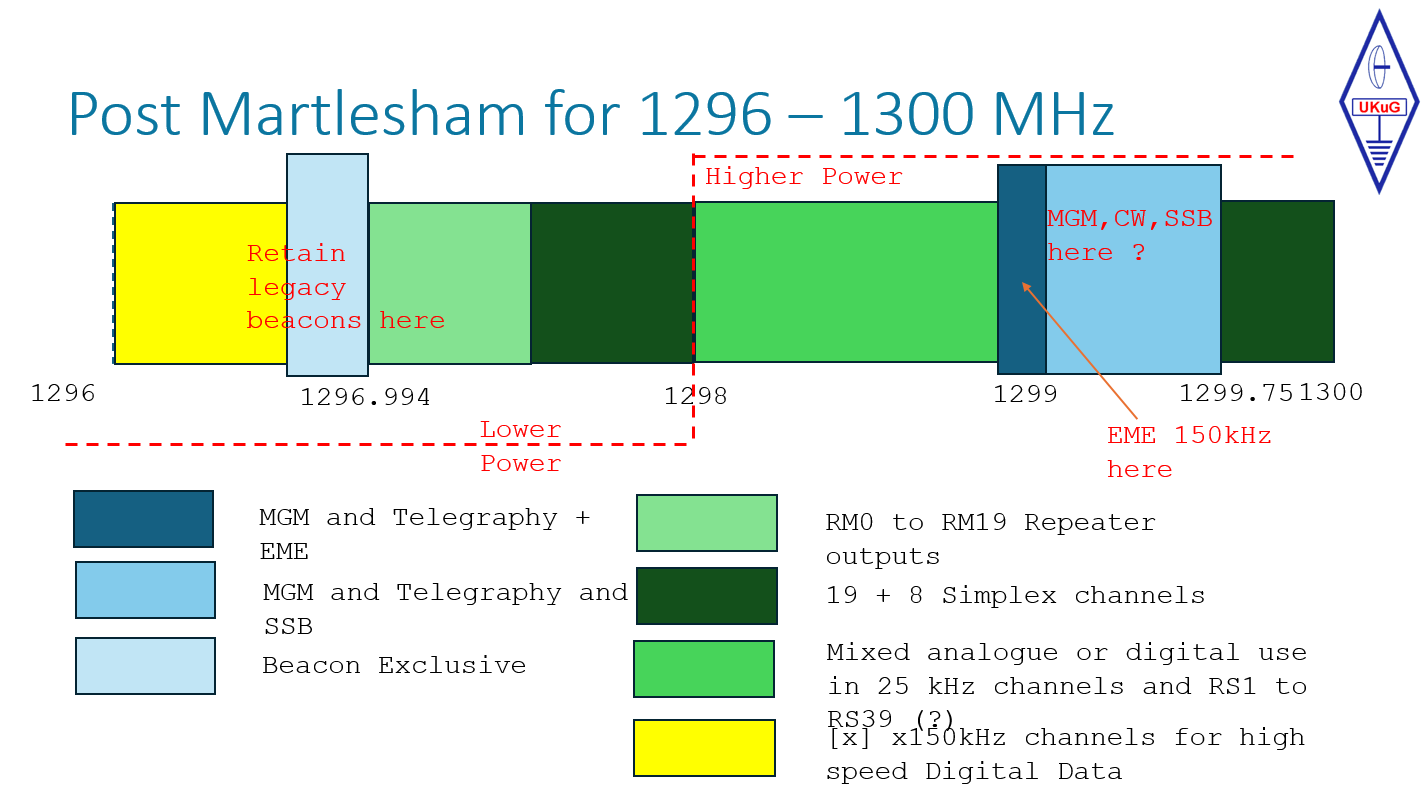 G4SJH 1296-1300MHz slide discussed at Martelsham
G4SJH 1296-1300MHz slide discussed at Martelsham